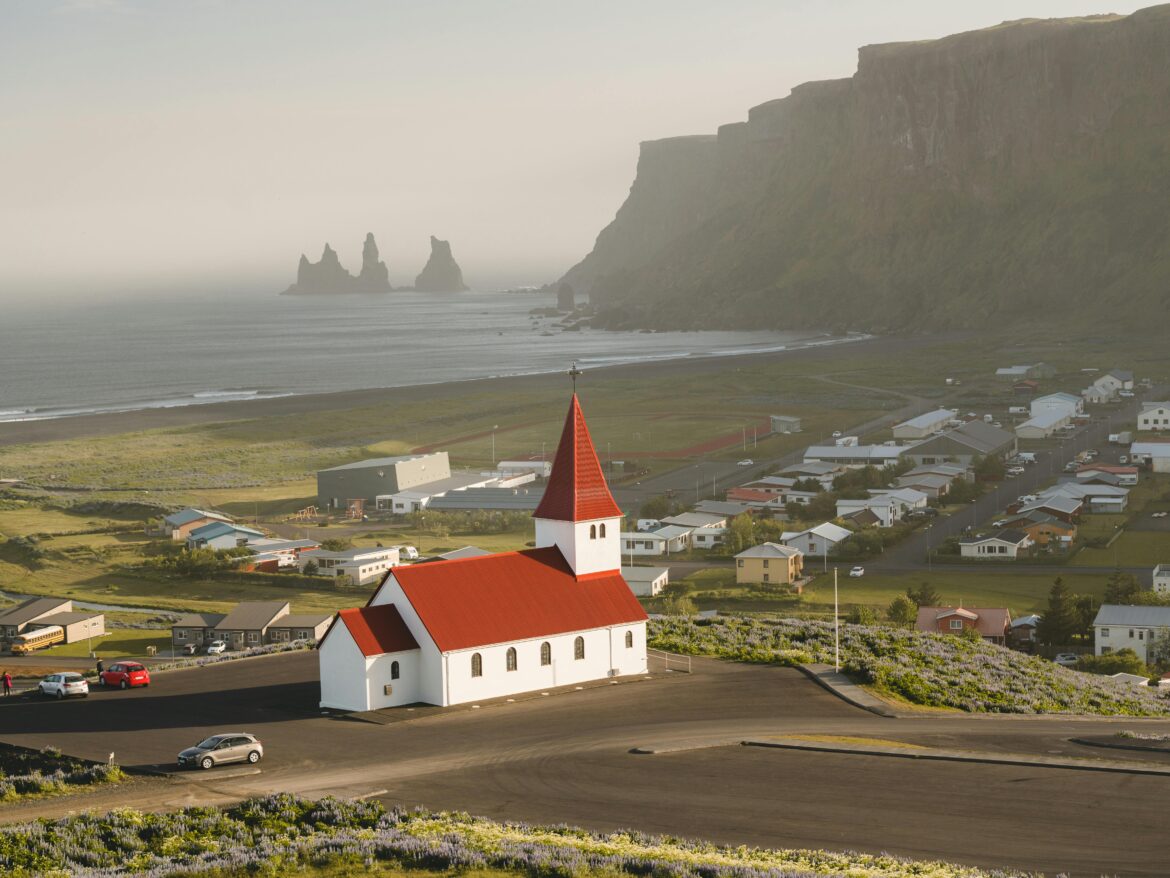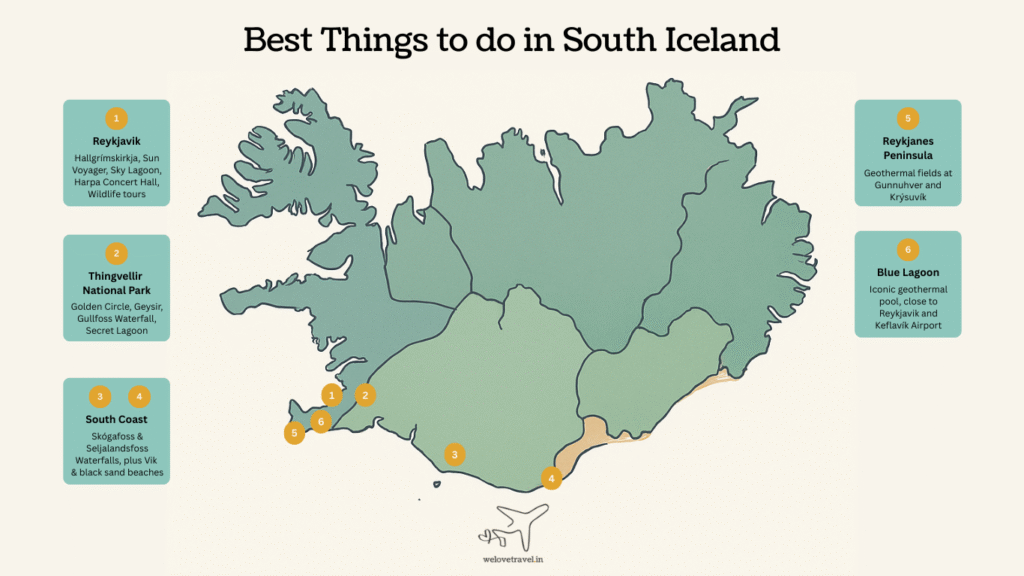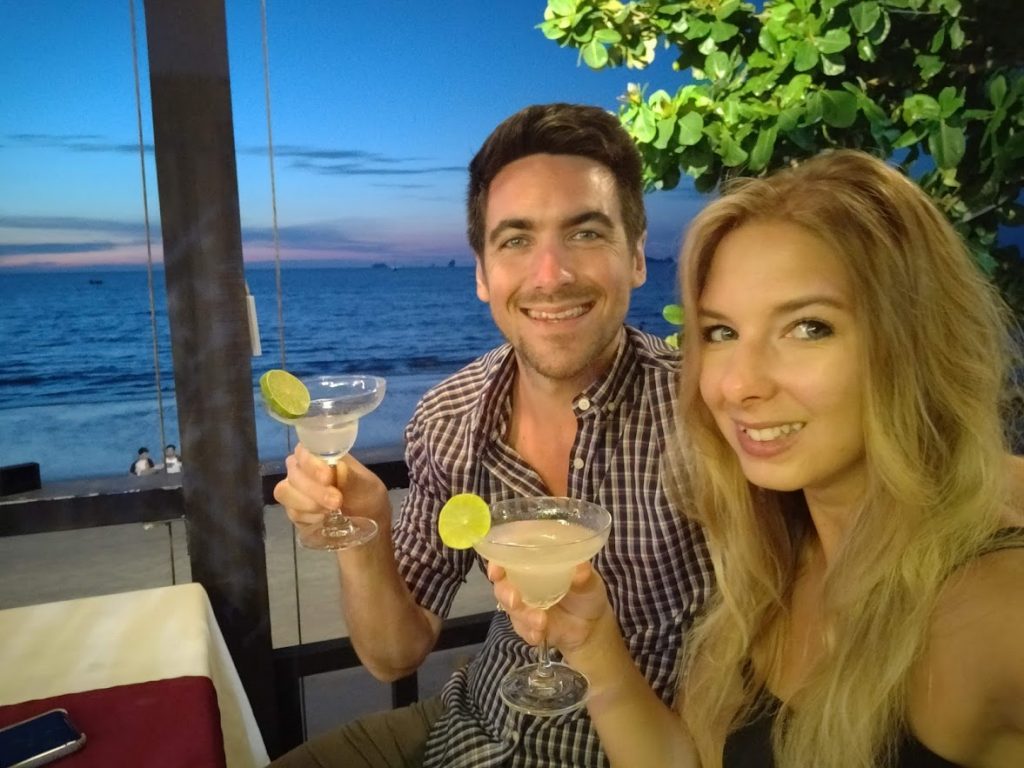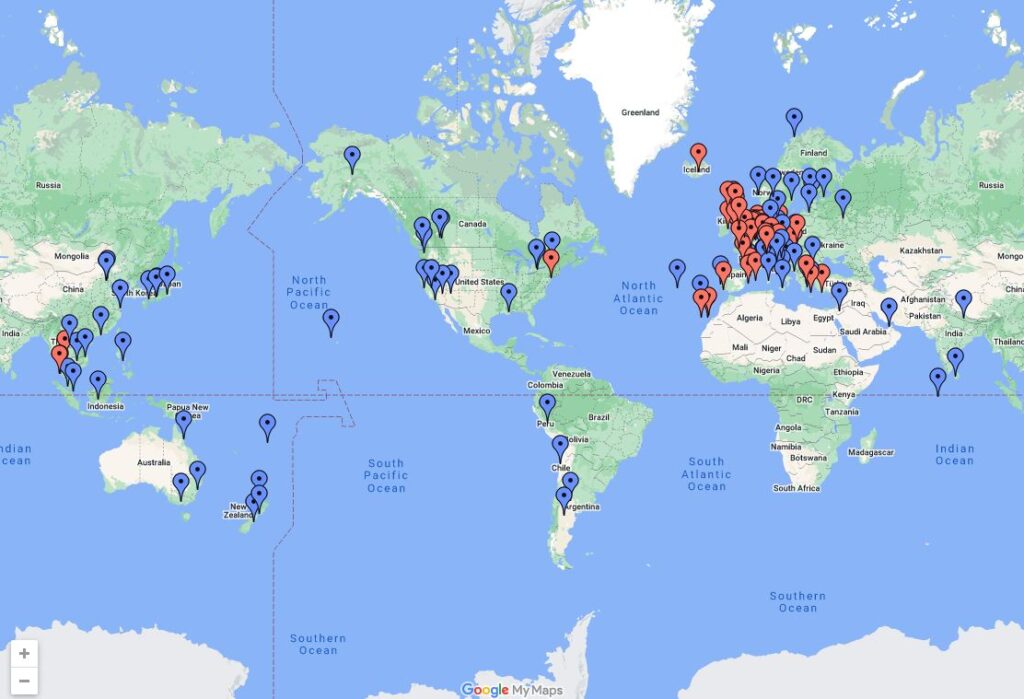 30 Best Things to See and Do in Iceland
30 Best Things to See and Do in Iceland
If you’re planning your first trip to Iceland and looking for a list of the best things to do in Iceland, then you have come to the right place! Iceland is well-known as the land of fire and ice. From dramatic mountains and rugged cliffs, to huge erupting geysers, thundering waterfalls and bubbling hot springs, Iceland has it all. By exploring the south of the country, you can experience some of the best things to see and do in Iceland!
We visited Iceland during one Snowy November, and we jammed in as much as we could during our trip. From exploring the Golden Circle and soaking up the hot springs, to uncovering some hidden gems and even seeing the Northern Lights! So here’s our definitive list of the 30 top things to do in Iceland!
Of course, Iceland is a vast and beautiful country! It would be impossible to condense the whole country into just 30 things. For the purposes of this post, we’ll cover the main areas of Southern Iceland. Specifically, the best things to see and do in Reykjavik, Thingvellir National Park, the South Coast & Vik and the Reykjanes Peninsula, including the Blue Lagoon. You can be sure we’ve rounded up some of the best things to see and do in Iceland, including not only the main sights and attractions, but some hidden gems worth visiting too!
We have categorised this post into those key areas and added locations for each in the below map. Blue for Reykjavik. Orange for Thingvellir National Park. Teal for the South Coast and Vik. Maroon for Reykjanes Peninsula and Blue Lagoon. Making it easy to help you plan your day-by-day itinerary of the best things to do in Iceland!
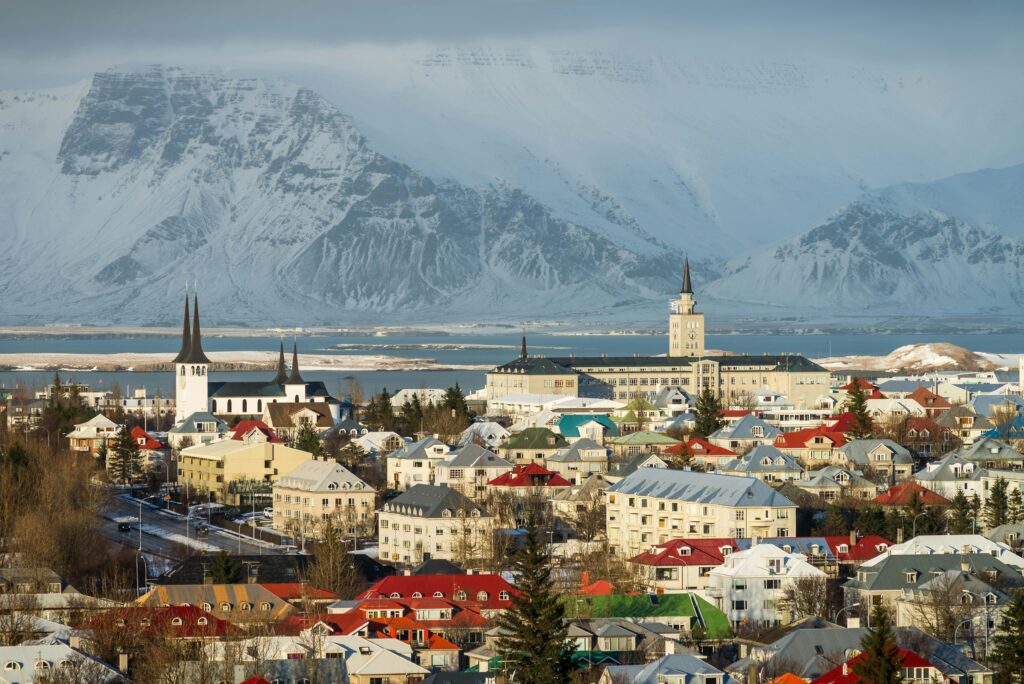
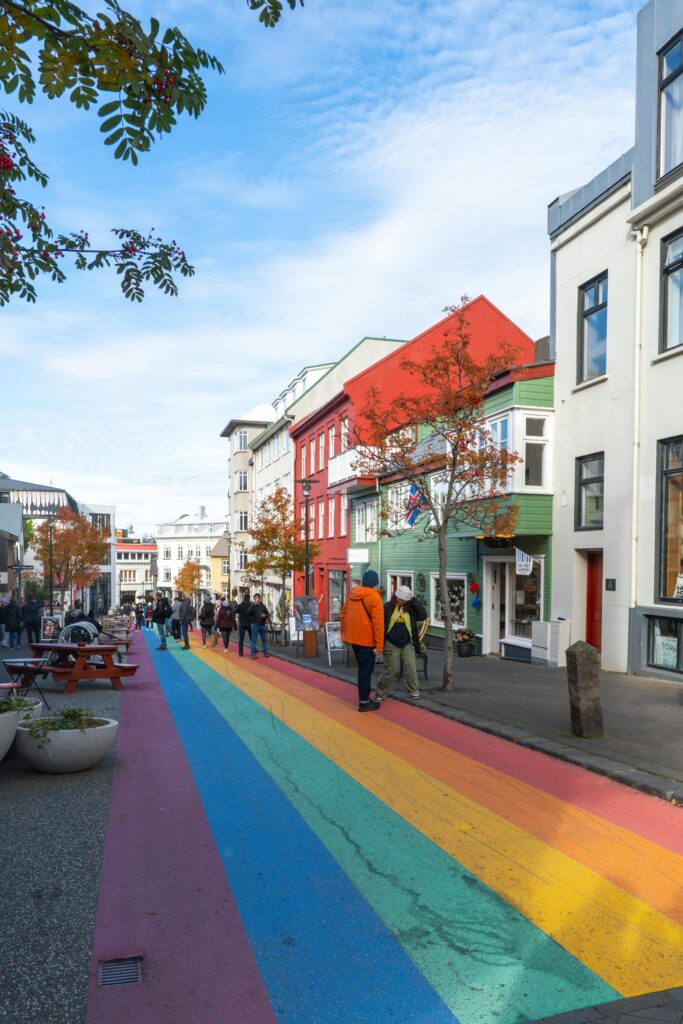
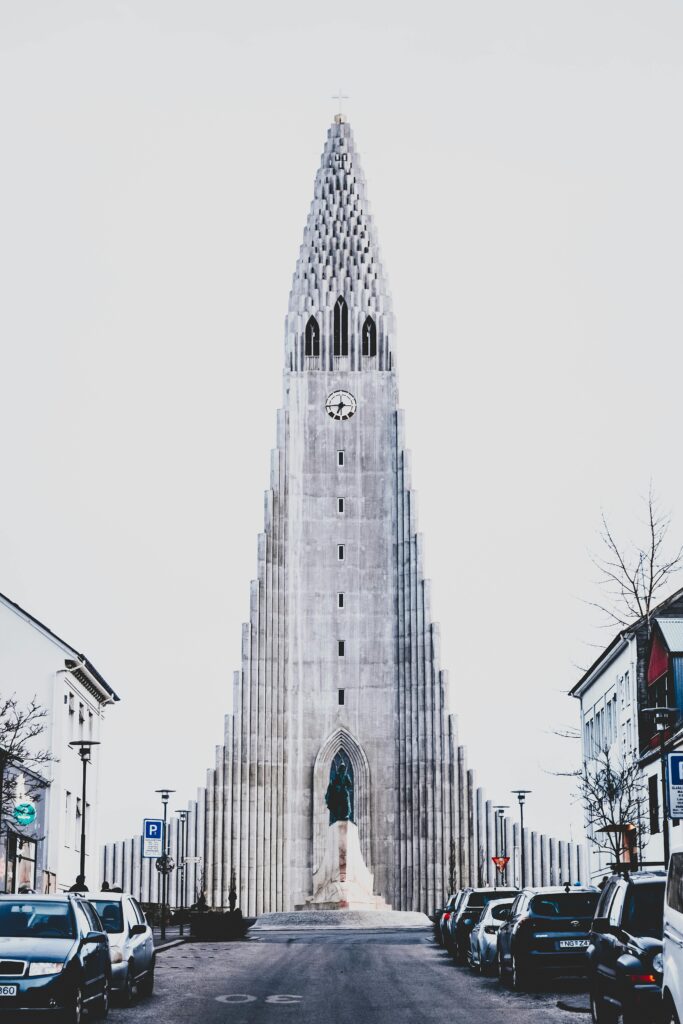
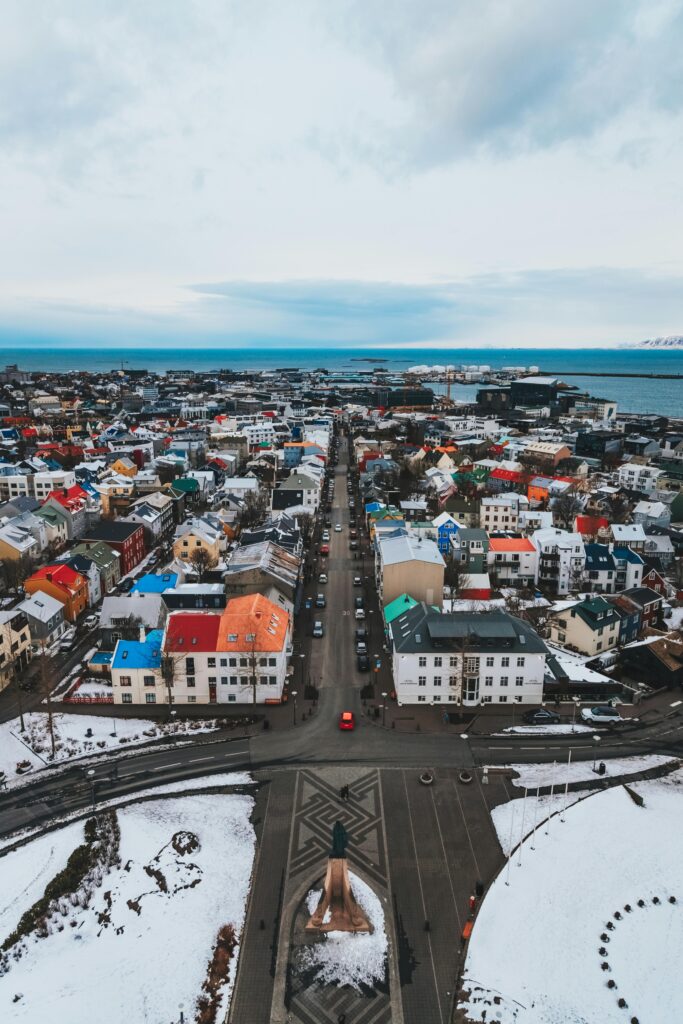
1. Explore Reykjavik
Most visitors stay in Reykjavik during their time in Iceland. So it makes sense that our list of things to do in Iceland starts here! But even if you’re staying further away, Reykjavik is definitely a must visit. Reykjavik (“Bay of Smokes”) was founded in 874, originally as a small fishing village. Since then, it has evolved into Iceland’s capital, becoming one of Europe’s most captivating cities. Reykjavik has so much offer. Some main highlights include:
Hallgrimskirkja – at 73 meters high, it is the largest church in all of Iceland. It also provides beautiful 360° views from its viewing platform at the top. Views span across Reykjavik city and the nearby mountains. You can see Esja, Reykjavik’s landmark mountain, and out to the ocean looking towards Greenland.
Sun Voyager – this modern metal structure can be found by the shoreline looking towards Esja. It was created to celebrate the city’s 200th birthday and represents hope, progress and freedom.
Harpa Concert Hall – this impressive concert hall and conference centre is home to the Iceland Symphony Orchestra, The Icelandic Opera and the Reykjavik Big Band! Harpa is a state of the art conference centre with a number of awards to its name for its architecture. Whether you see a performance at Harpa or not, the building is 100% worth a visit and an explore.
Laugavegur – perhaps one of Reykjavik’s oldest streets! This is a bustling hub, home to lots of cafes, shops, restaurants and bars – enjoy!
This really is just the tip of the iceberg and Reykjavik has so much to offer. We have written a more in-depth trip report of our 7 days in Iceland, including what we got up to in Reykjavik here.
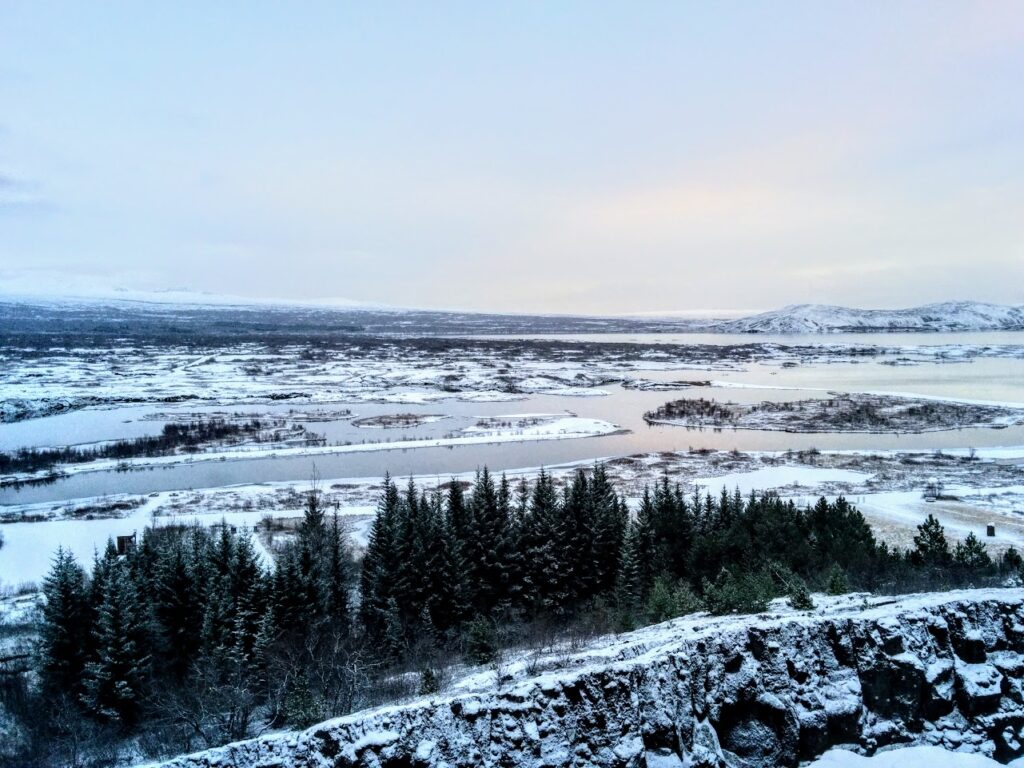
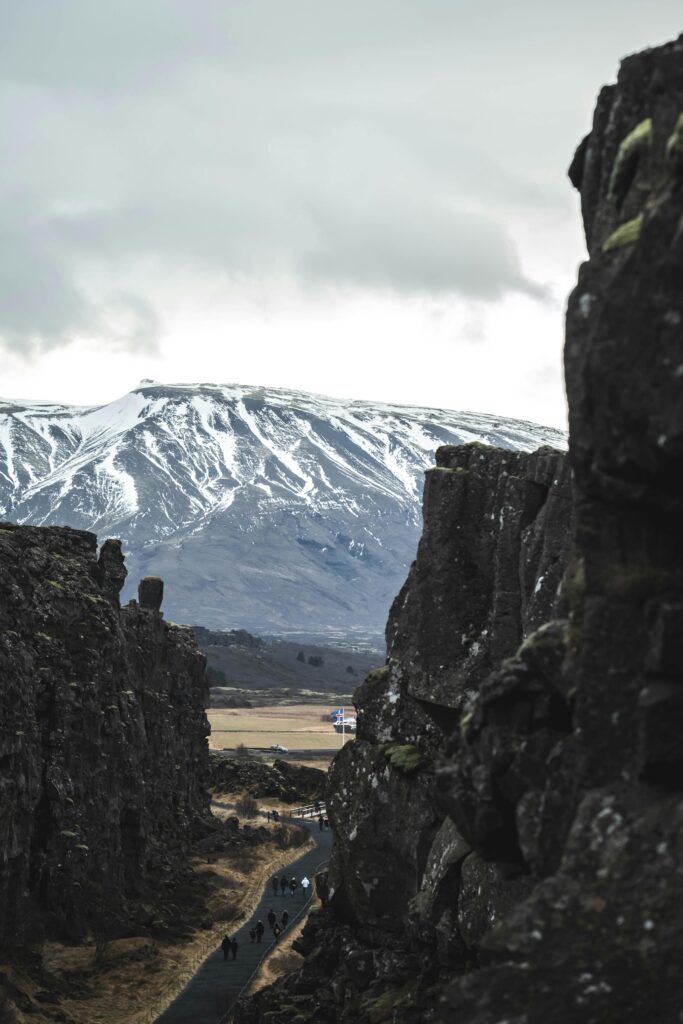
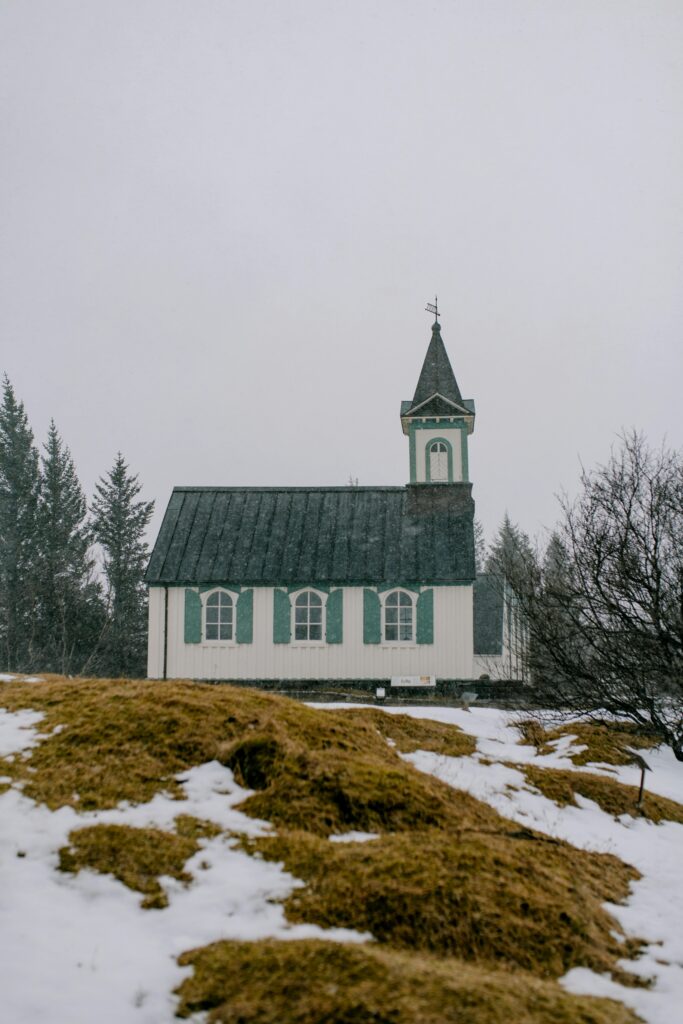
2. Thingvellir National Park
Not only is Thingvellir National Park home to some of the most iconic things to see and do in Iceland, it is also worth a visit in its own right. A UNESCO World Heritage Site, it is known for its unique geological features and combines dramatic, yet stunning natural scenery, with deep cultural significance as the birthplace of Iceland’s parliament, way back in 930 AD!
It is located about 53 kilometres (33 miles) from Reykjavík and is home to the famous Golden Circle (more on this below). The park also sits between the North American and Eurasian tectonic plates. You can literally walk (and dive) between two continents! More on this also below…
But these are just a couple of the main highlights. With its striking cliffs, waterfalls, and views over Iceland’s largest natural lake, it’s a must-see stop on your trip around Iceland.
There’s no entrance fee to enter the park, and parking is about £6 all day.
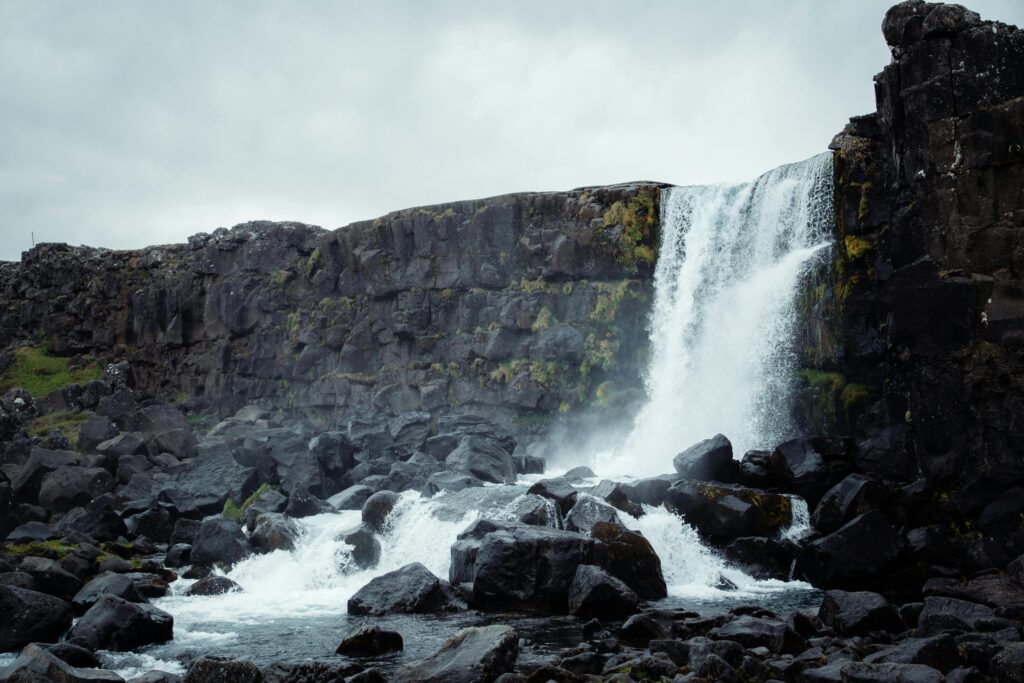
3. Öxarárfoss
Öxarárfoss is one of many waterfalls on this list – but for good reason! From the main parking area, a short 15-minute walk takes you along marked trails to a series of viewpoints overlooking the falls. Standing at 13 metres high, Öxarárfoss tumbles over lava rock in a dramatic setting that once played an important role in Iceland’s history. The waterfall once served as a natural amphitheatre during political gatherings, where the law speaker would address the crowds. Once upon a time, early Icelandic settlers would discuss laws and disputes. Today, it’s a peaceful spot to enjoy the scenery and experience one of the park’s most picturesque locations.
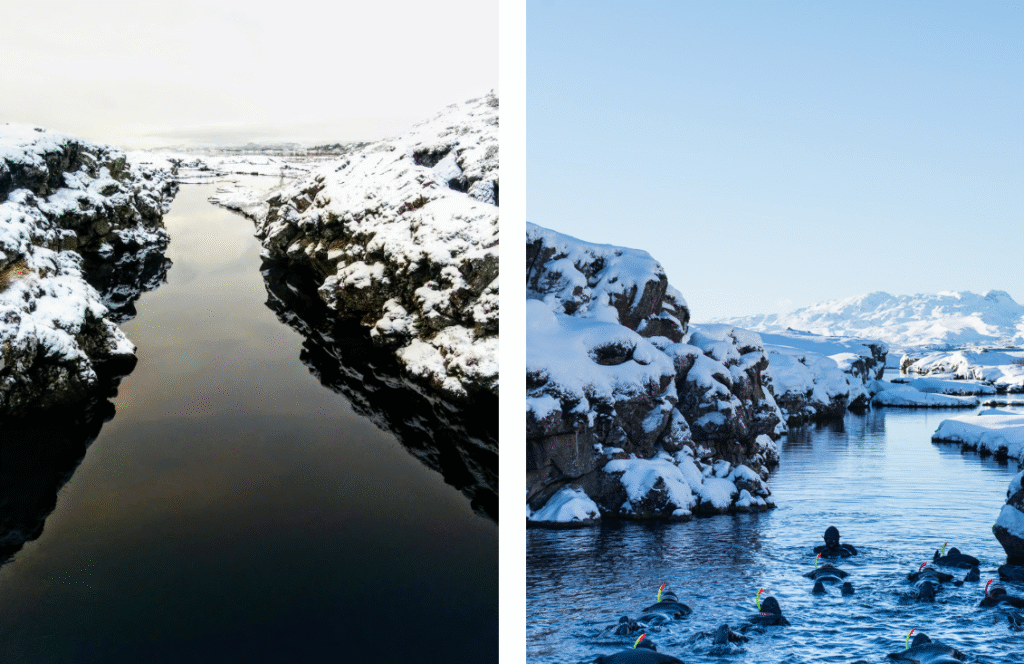
4. Go Diving at Silfra
Visiting the Silfra fissure is one of the most extraordinary things to do in Iceland. In fact, it’s a one-of-a-kind experience in the world!
Also located in Thingvellir National Park, it’s the only place on Earth where you can snorkel or dive directly between two drifting tectonic plates: the North American and Eurasian. The water here is glacial, naturally filtered through lava rock over decades, which makes it unbelievably pure! Our photo, taken one snowy November unfortunately doesn’t do it justice, but if you go diving you will have up to 100 metres of visibility. It is some of the clearest water on the planet! The temperature does however stay at a chilly 2–4°C year-round! But with a dry suit and a guided tour, you’ll stay comfortable as you float through underwater world.
But if you’d rather keep your feet on dry land, then you always opt t walk across the bridge which spans the two tectonic plates.
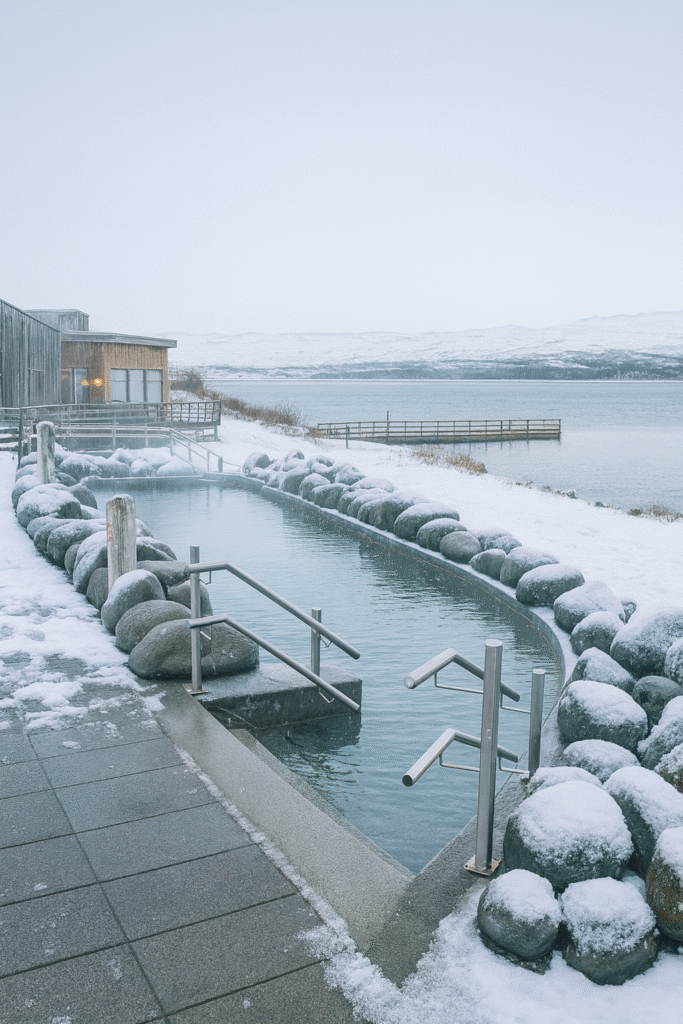
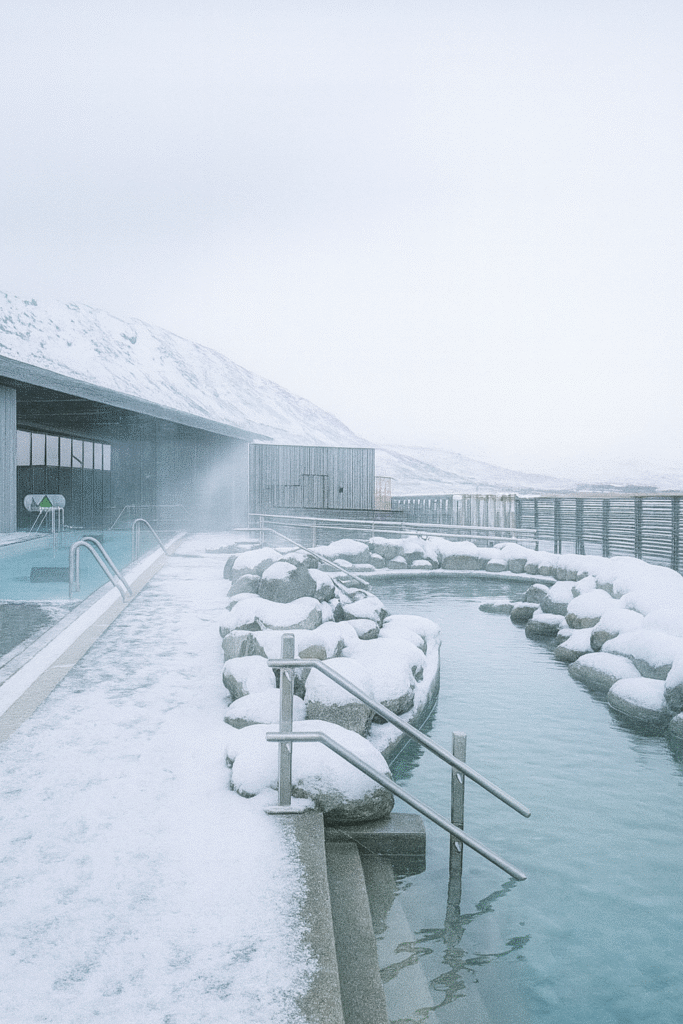
5. Take a Dip at Laugarvatn Fontana
Spending time in one of Iceland’s many geothermal pools should always be on your list of top things to do in Iceland. Laugarvatn Fontana is no exception. But, unlike some of Iceland’s more famous spas, Laugarvatn Fontana offers a smaller, more intimate experience. Nestled on the shores of Lake Laugarvatn, within Thingvellir National Park. You can switch between steaming geothermal pools and a bracing dip in the lake itself — a true Nordic experience!
The geothermal bakery is another highlight, letting you watch (and taste) rye bread baked underground using natural heat. It’s a perfect stop that combines relaxation, local culture, and stunning lakeside scenery without the big-crowd feel.
Fontana is open daily from 10am to 9pm during the summer. For the rest of the year, it’s open from 11am to 9pm. Parking is available at the spa, and you can rent towels, bathrobes, and swimsuits on site. Of course times and entrance fees are always subject to change, so be sure to check out their website for updates and to book your tickets.
6. Brúarfoss Waterfall
Brúarfoss, often called the “Blue Waterfall,” is one of Iceland’s hidden gems and a must-visit if you’re exploring Thingvellir Park. This lesser-known cascade is famous for its striking turquoise water. It flows over dark volcanic rock in hundreds of small streamlets, creating a dramatic frothy effect. Unlike some of Iceland’s more crowded waterfalls, Brúarfoss feels more peaceful and off the beaten path. This makes it one of the best things to see and do in Iceland and worth adding to your list!
Its vivid blue colour — especially on a sunny day — makes it one of the most photogenic waterfalls in the country.
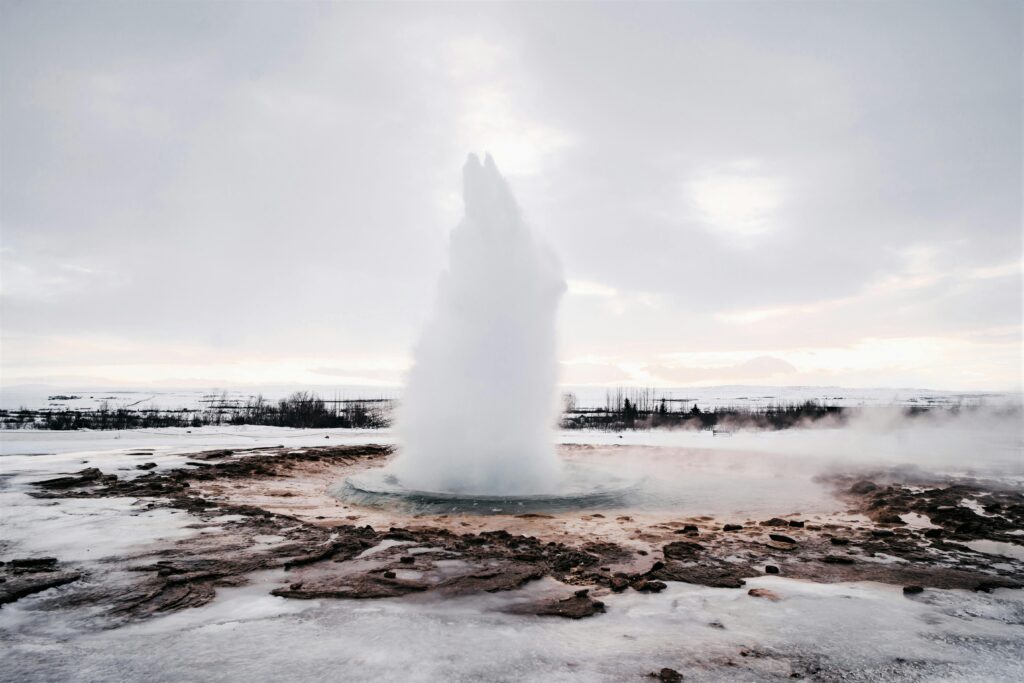
7. Gasp at Strokkur and Geysir
A little further up the road – still within Thingvellir National Park – is the Geysir Geothermal area. This area is famous for its natural wonders and will undoubtably be on everyone’s list of things to see and do in Iceland! This area is filled with steaming vents, bubbling mud pots, and colourful geothermal pools. But its two stars are Geysir and Strokkur. This area gave us the word “geyser” that we all know and use today. As a result, many assume they’re watching Geysir. But it’s Strokkur that reliably puts on the performance.
Geysir is the original hot spring, once shooting boiling water up to 70 metres into the sky! These days it erupts rarely – only after significant activity like earthquakes.
Just a few steps away, however, is Strokkur, Iceland’s most reliable geyser. Strokkur erupts every 5–10 minutes, sending jets of water 15–20 metres high — sometimes even higher. Watching the water bubble, dome, and then explode skyward is an unforgettable experience and one of the true highlights of Iceland.
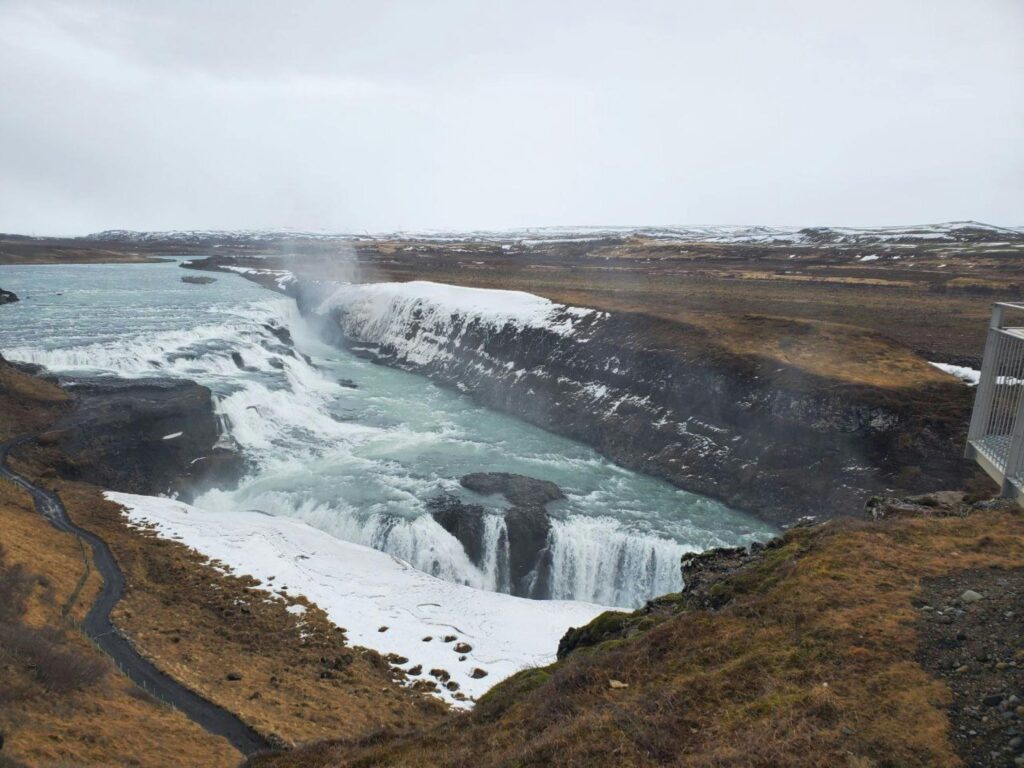
8. Witness the Rush of Gullfoss
Gullfoss, or the “Golden Falls,” is one of Iceland’s most iconic and powerful waterfalls. Here, the Hvítá river plunges in two dramatic stages into a rugged canyon. Water sprays high into the air, often creating shimmering rainbows (on sunny days, which ours was not!).
What makes Gullfoss so special is not only its sheer scale but also its accessibility! You can view it from several platforms, including a path that takes you right to the edge of the roaring water in summer. In the winter it becomes an ice rink, so is inaccessible unfortunately. But there are still lots of other places to view these magnificent waterfalls.
9. Faxafoss Waterfall
Faxafoss is a wide, graceful waterfall located just a short drive from Gullfoss! Though much smaller in scale, but not less worth seeing. The water cascades in a broad sheet over a 7-metre drop. Unlike the dramatic roar of Gullfoss, Faxafoss has a calmer, more tranquil atmosphere, making it a great stop for a quieter moment. There’s a viewing platform close to the falls, as well as a nearby salmon ladder — built to help fish navigate the river — which adds an interesting detail to the visit. Its accessibility and serene setting make Faxafoss a worthwhile addition to your time in Iceland.
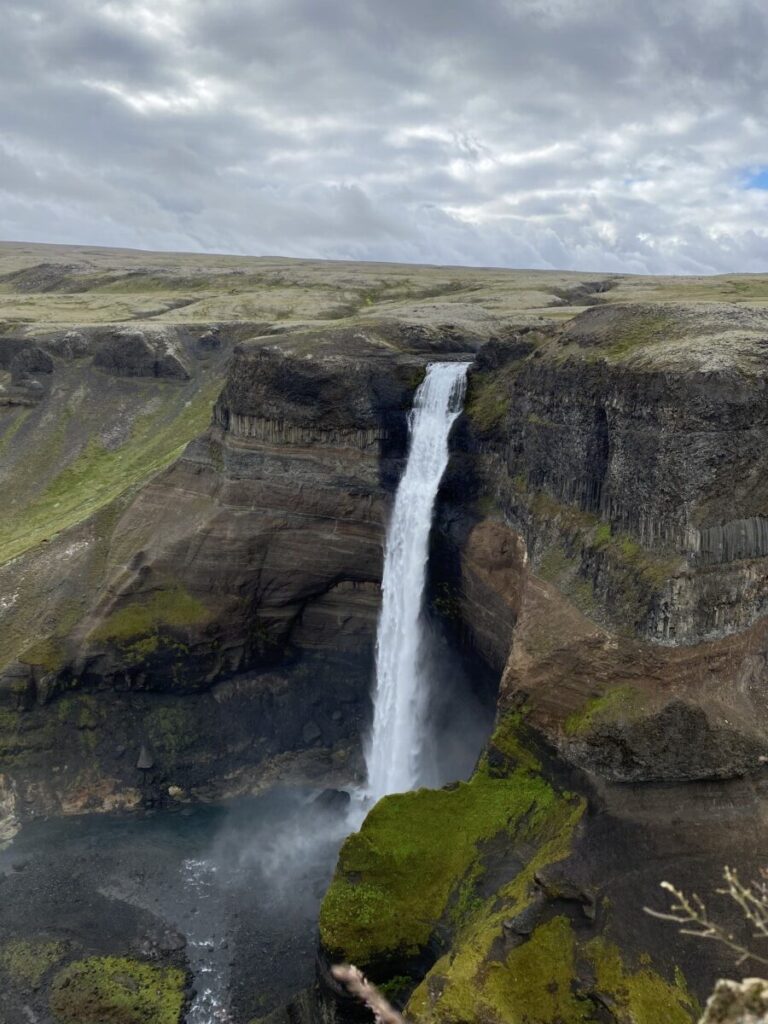
10. Hike Up to Haifoss
Definitely one of the best things to see and do in Iceland, is hike up to the mighty Háifoss. Meaning “High Falls,” it is one of Iceland’s tallest waterfalls. Plunging an impressive 122 metres into a rugged canyon in the valley below.
The falls are surrounded by dramatic cliffs and sweeping views of the Icelandic highlands. A short hike from the car park leads to stunning viewpoints, where you can often spot the neighbouring waterfall Granni cascading alongside it. The combination of towering drops, volcanic landscapes, and relative solitude makes Háifoss a rewarding stop!
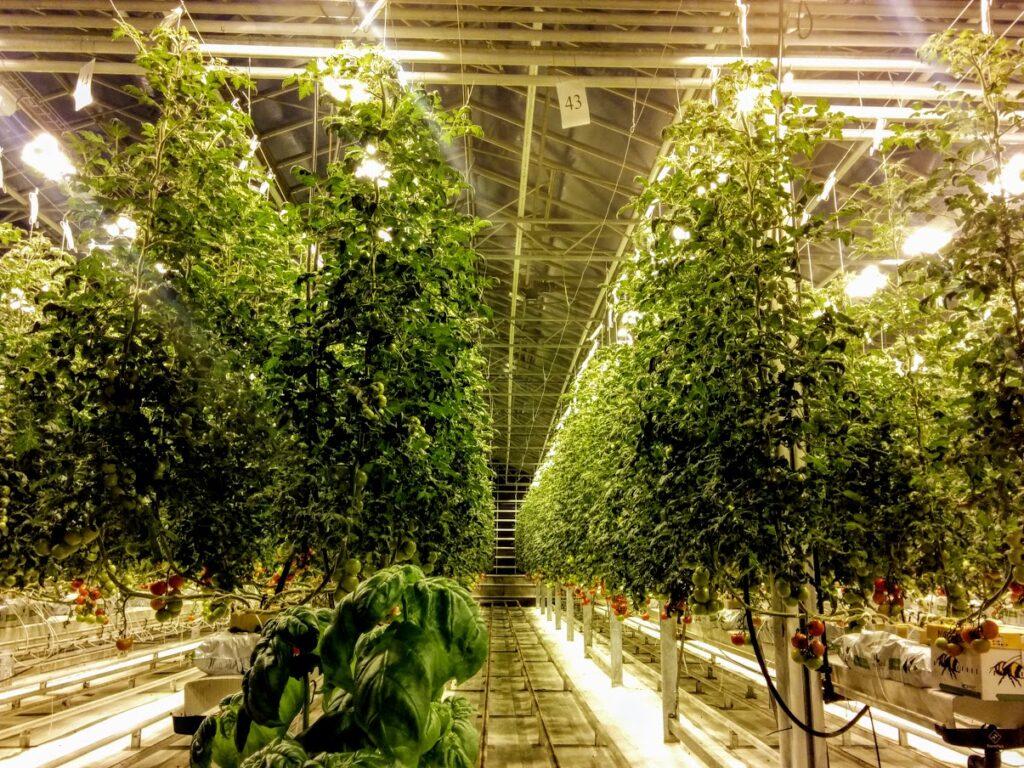
11. Eat at a Geothermally Powered Restaurant
Something you don’t see everyday… A tomato greenhouse with an on-site restaurant. All 100% powered by natural geothermal activity!
The restaurant serves all kinds of delicious tomato-based drinks and meals – from beers and Bloody Mary’s, to wholesome pasta dishes and homemade tomato soup. You can dine at tables located within the greenhouse and admire their towering tomato plants while you eat. It’s a cute and unique experience!
Friðheimar is located just off the main Golden Circle route, so it’s worth a visit for a nice hearty lunch.
12. Relax at The Secret Lagoon
The Secret Lagoon is Iceland’s oldest geothermal hot spring located in the small village of Flúðir. Built in 1891, it offers a more rustic and traditional experience compared to the bigger, modern spas. The pool is fed by natural hot springs, keeping the water at a soothing 38–40°C year-round, surrounded by steamy vents and even a small geyser that erupts every few minutes.
This was personally our favourite hot spring! It was much quieter than some of the other well known spots. It also started to snow during our visit – there’s nothing like the sensation of dipping your cold shoulders under the 38°C water, as it lightly snows around you. A trip here is a lovely way to spend a couple of hours.
13. Kerid Crater
A visit to Kerið crater is one of the most striking things to do in Iceland. Known for its vivid red volcanic rock and the bright blue lake that fills its basin.
The crater formed around 3,000 years ago, and is 55 metres deep, 170 metres wide, and 270 metres across! You can easily walk around the rim for sweeping views of the colourful contrasts. A path also leads down to the water’s edge, where you can appreciate the crater from below. Its unique palette of fiery rock against the turquoise lake makes it especially photogenic, and a great way to experience Iceland’s volcanic landscape up close.
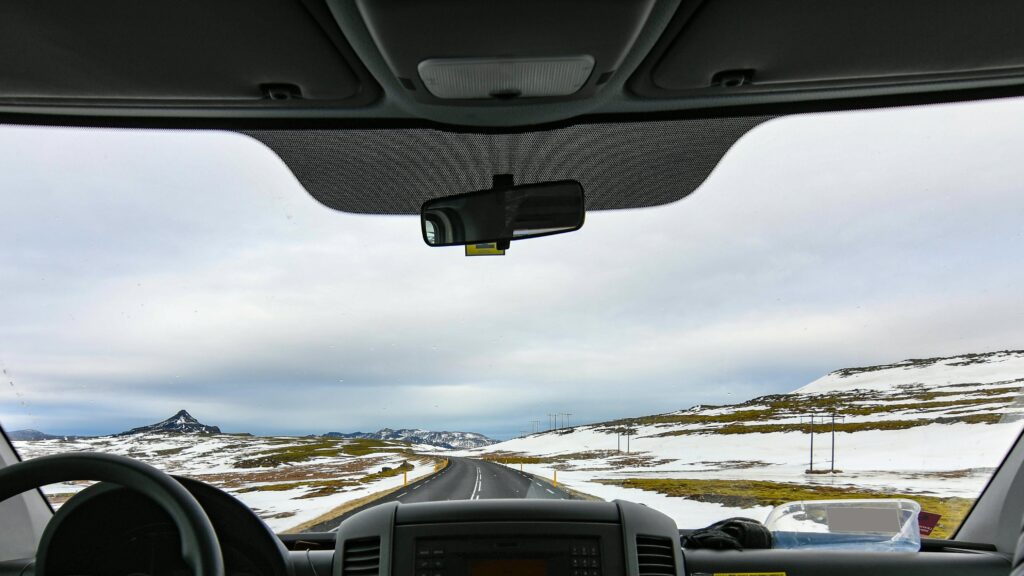
14. Complete Iceland’s Golden Circle
Or why not bring together all of the above into one epic day and tick off Iceland’s Golden Circle? The Golden Circle is Iceland’s most popular sightseeing route. Looping 300 kilometres from Reykjavík through some of the country’s most iconic natural and cultural landmarks.
The official stops include: Thingvellir National Park, Geysir and Gullfoss. But with so much more to see and do in the area, it’s easy to tag on extra sights and stops. The Golden Circle can either be done via an organised tour (there are dozens of tour companies to pick from), or you can hire a car and organise your own self-drive tour, which is what we did.
However you choose to do the Golden Circle you are guaranteed an action-packed day! Iceland truly is a stunning one-of-a-kind country. If you’re interested in knowing a little more, we have included a more detailed write-up on our post about doing a self-drive Golden Circle Tour here.
15. Explore Iceland’s South Coast
Iceland’s South Coast is one of the most breathtaking regions in the country. Offering a mix of waterfalls, glaciers, black sand beaches, and dramatic sea cliffs all within easy reach of Reykjavík. You’ll pass some of Iceland’s most famous landmarks — from Seljalandsfoss and Skógafoss to the Reynisfjara black sand beach — alongside plenty of hidden gems which often get overlooked in favour of these big three.
The area combines raw natural power with otherworldly beauty, making it one of the best places to experience the diversity of Iceland’s landscapes. If you’re short on time, the spots we’d recommend the most are all listed below.
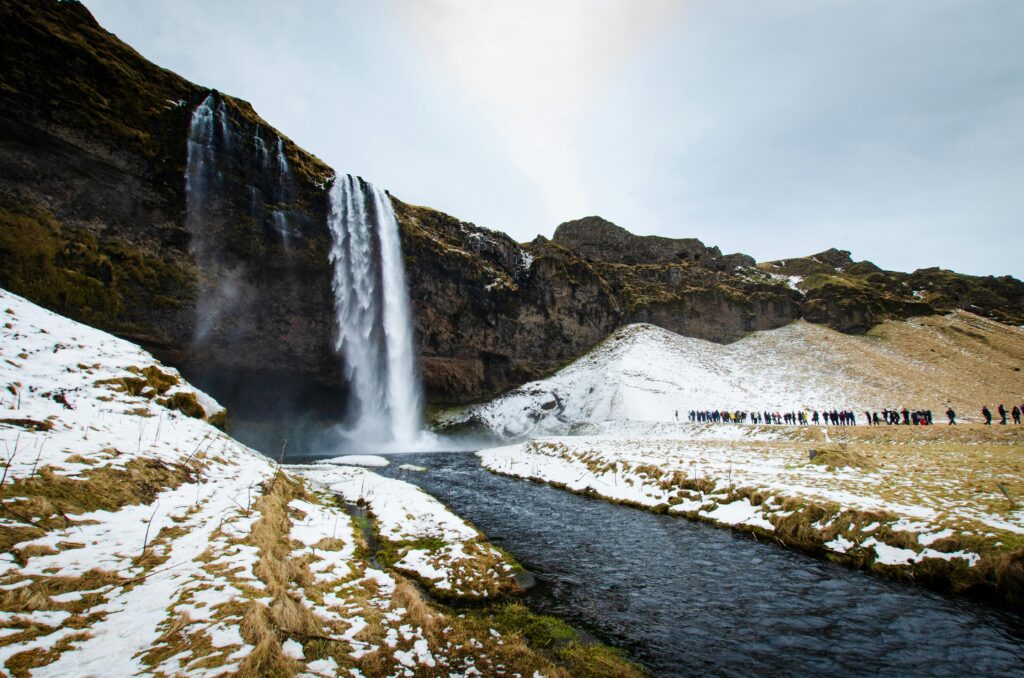
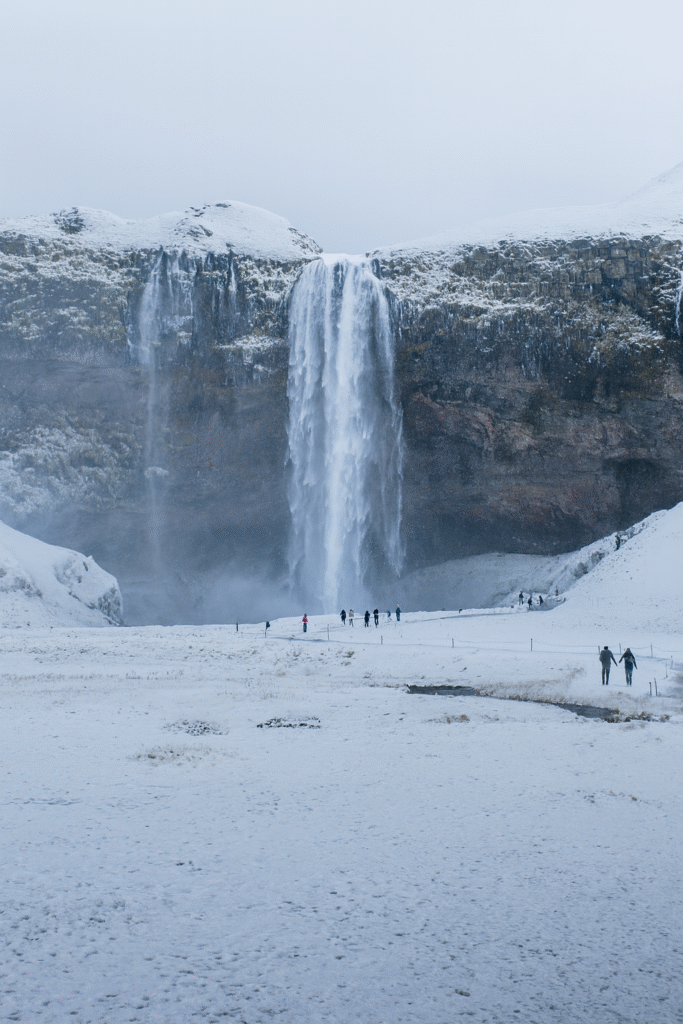
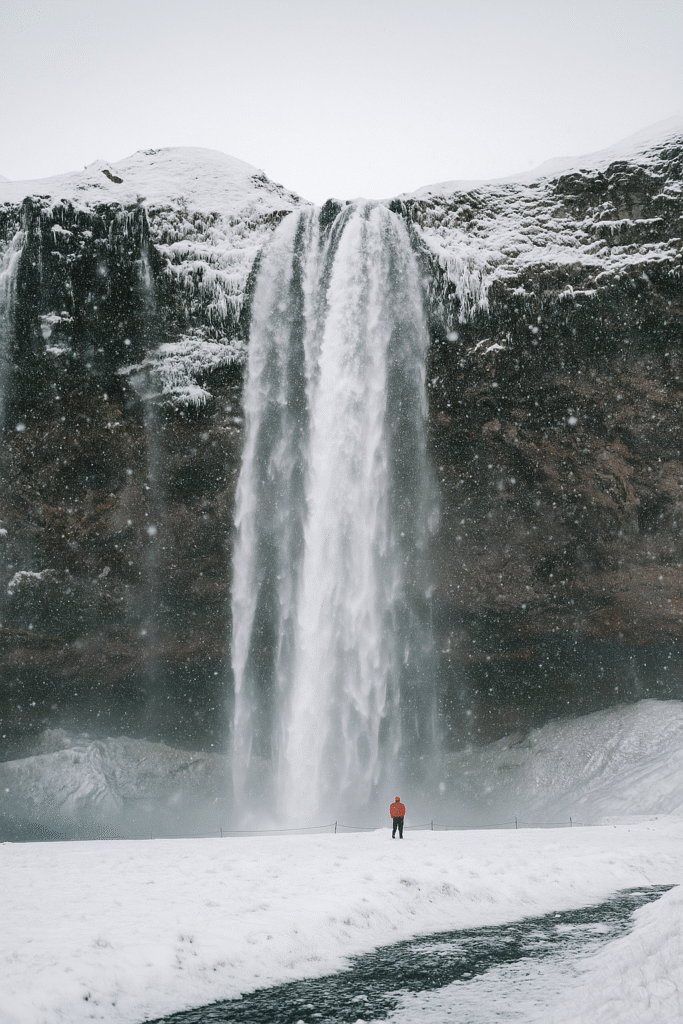
16. Gaze at Seljalandsfoss
Soaking up the beauty of Iceland is one of the best things to see and do in Iceland. And Seljalandsfoss is no exception. Dropping 60 metres from the cliffs above, it’s not just the dramatic view from the front that makes it special, but the rare opportunity to walk all the way behind the waterfall too! (Unfortunately not open in the winter months when it snows).
Visiting is super straightforward too. Seljalandsfoss sits right off the Ring Road, about 2 hours from Reykjavík. There’s a dedicated parking area and easy access via a short walk. Waterproof clothing is a must if you plan to go behind the falls. With its unique walk-behind path and stunning scenery, Seljalandsfoss offers one of the most memorable waterfall encounters in Iceland.
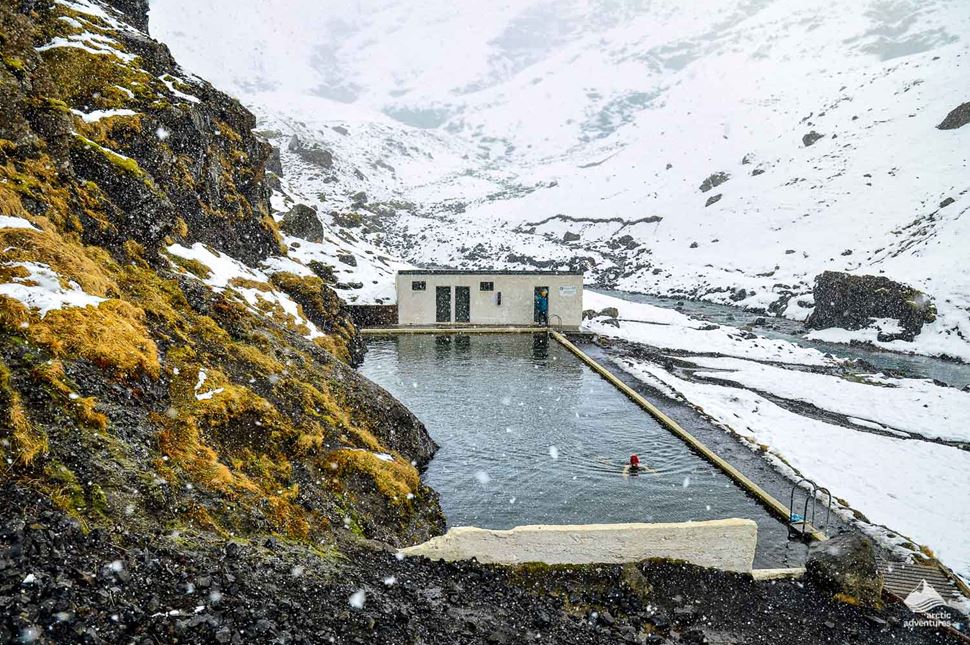
17. Seljavallalaug Swimming Pool
Tucked away in a quiet valley beneath the Eyjafjallajökull volcano, Seljavallalaug is one of Iceland’s most unique and atmospheric swimming pools. Built in 1923, it’s one of the oldest pools in the country and was originally created to teach locals how to swim.
The pool is fed by natural hot spring water. That said, it’s not as hot as other springs suchas the Secret Lagoon. However it is surrounded by dramatic mountains that give it an almost hidden, otherworldly feel. Getting there involves a short 15–20 minute walk from the nearest parking area. While facilities are very basic, the raw beauty of the setting more than makes up for it. If you’re looking for something a little wilder and more authentic, Seljavallalaug is worth a quick pit-stop along the south coastal road.
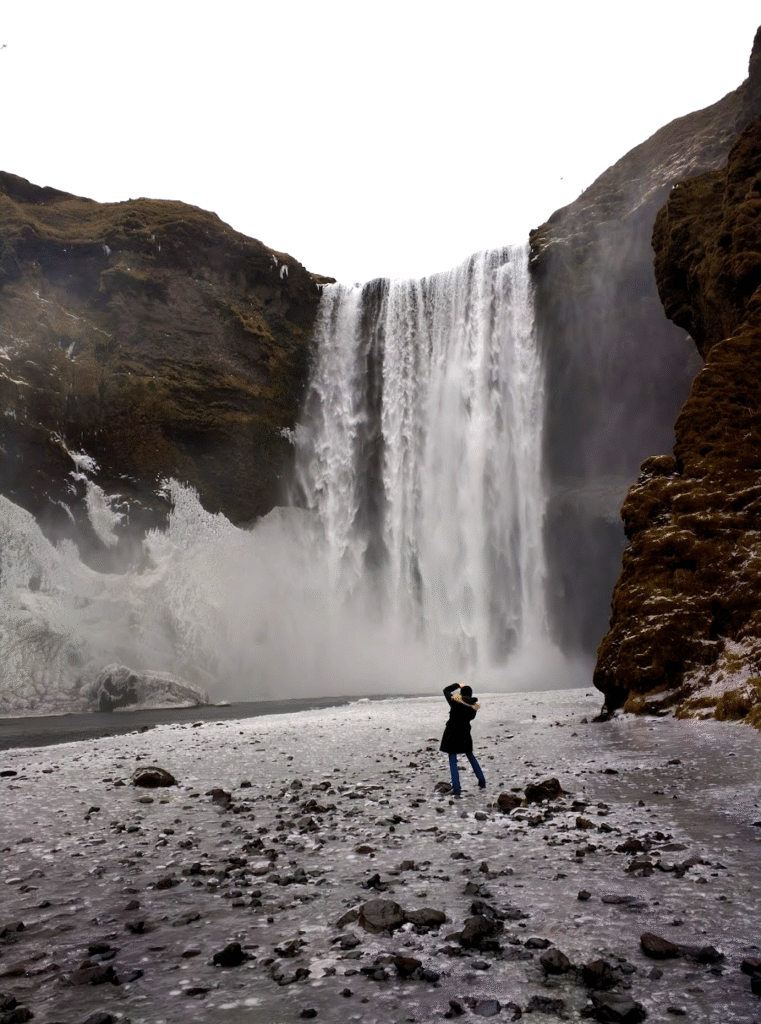
18. Witness Skogafoss
Standing at 25 meters wide and a drop of 60 meters, Skogafoss is one of Iceland’s biggest and most beautiful waterfalls. The falls create a constant mist that often produces vivid rainbows on sunny days.
What makes Skógafoss especially memorable is how close you can get. A short walk takes you right to the base, where you’ll feel the roar and spray of the water up close. Unfortunately, due to the huge amount of spray that the cascade produces, it’s unlikely you’ll get too close during the winter as the ground becomes an ice rink! For a different perspective, a staircase to the right of the falls leads to a viewing platform above, offering sweeping views over the coastline and the Skógá River as it winds inland.
19. Kvernufoss
Just a short walk from Skógafoss lies one of Iceland’s best-kept secrets — Kvernufoss. Tucked inside a mossy gorge, this graceful 30-metre waterfall feels wonderfully secluded compared to its famous neighbour. A 20-minute hike from the Skógar Museum leads you through rolling fields before the canyon walls rise up to reveal the falls. A narrow trail even lets you walk behind the curtain of water.
Kvernufoss is a peaceful escape that combines the thrill of discovery with the beauty of Iceland’s hidden landscapes. It’s the kind of spot that makes you feel like you’ve stumbled into a secret corner of the South Coast — and that’s well worth a detour.
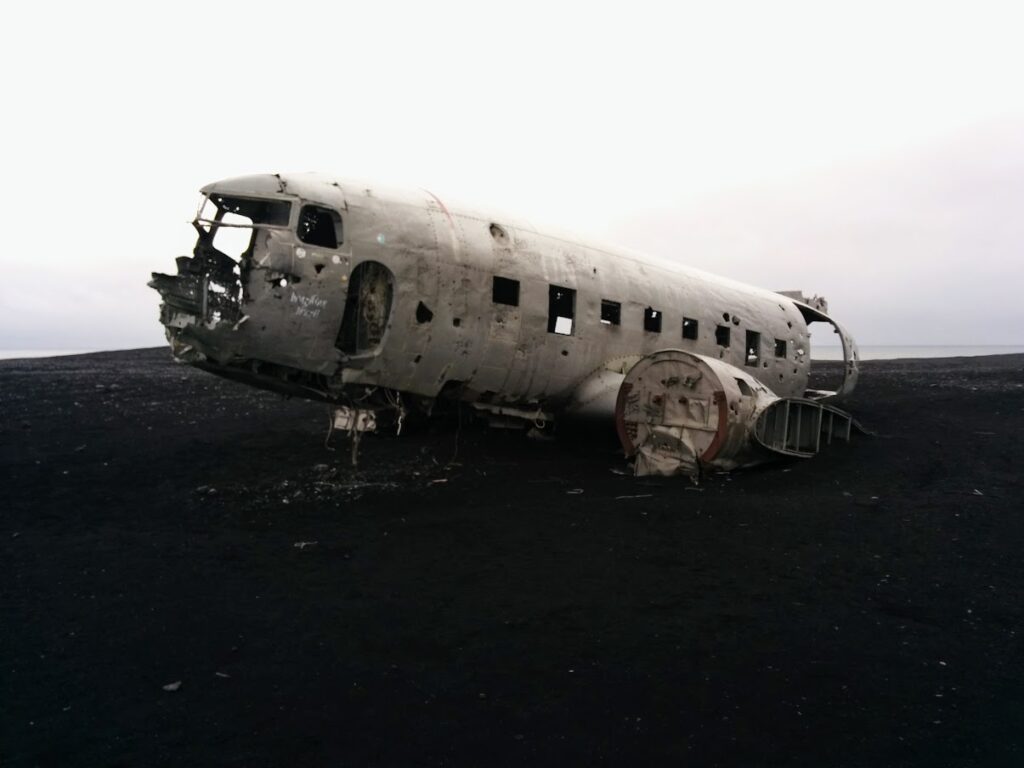
20. Visit the DC3 Plane Wreck
Once a well-kept secret, the DC3 Plane Wreck has now become a famous site, visited by tourists and photographers alike. It is widely speculated that the plane will not remain on the Southern shores of Iceland forever. Located not far from the Mýrdalsjökull Glacier, there is a very high chance that floodwater will wash the wreckage away during the next eruption from Katla (one of Iceland’s most explosive volcanoes). But for now, it’s still an interesting addition to your list of things to see and do in Iceland.
As to how the wreckage ended up on the shores of Sólheimasandur, no-one really knows for sure. The aircraft crashed in November 1973 after a forced landing. In that time the wreckage has grown in popularity. When we first visited, it was only possible to reach the wreck by driving down the bumpy beach in our 4×4. Nowadays you can either walk down from a new car park located just off the Ring Road, or you can pre-book a shuttle bus.
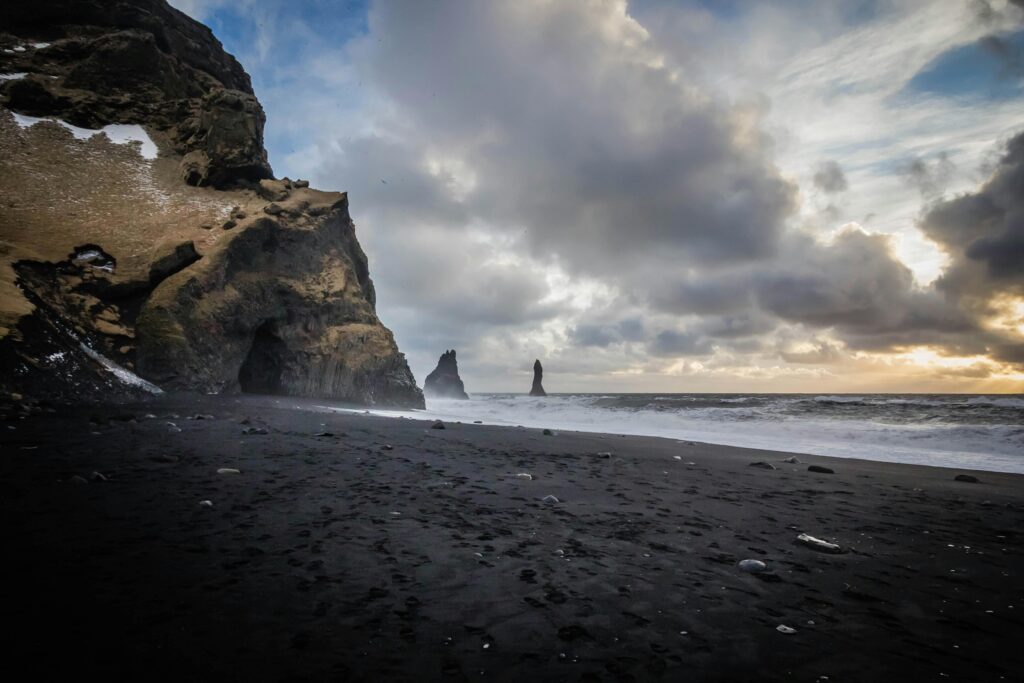
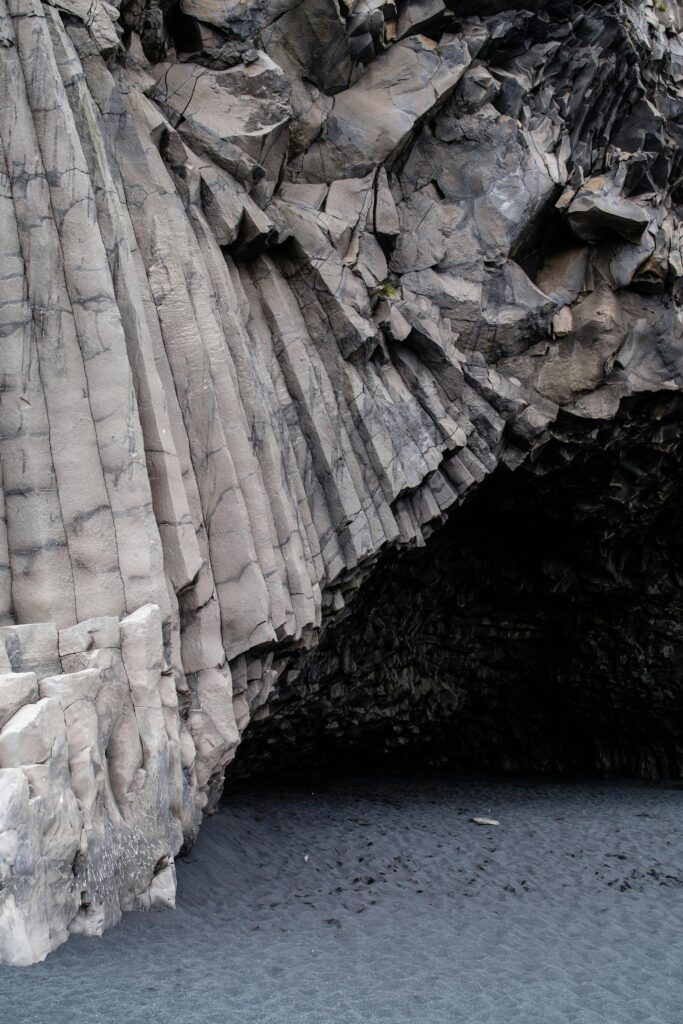
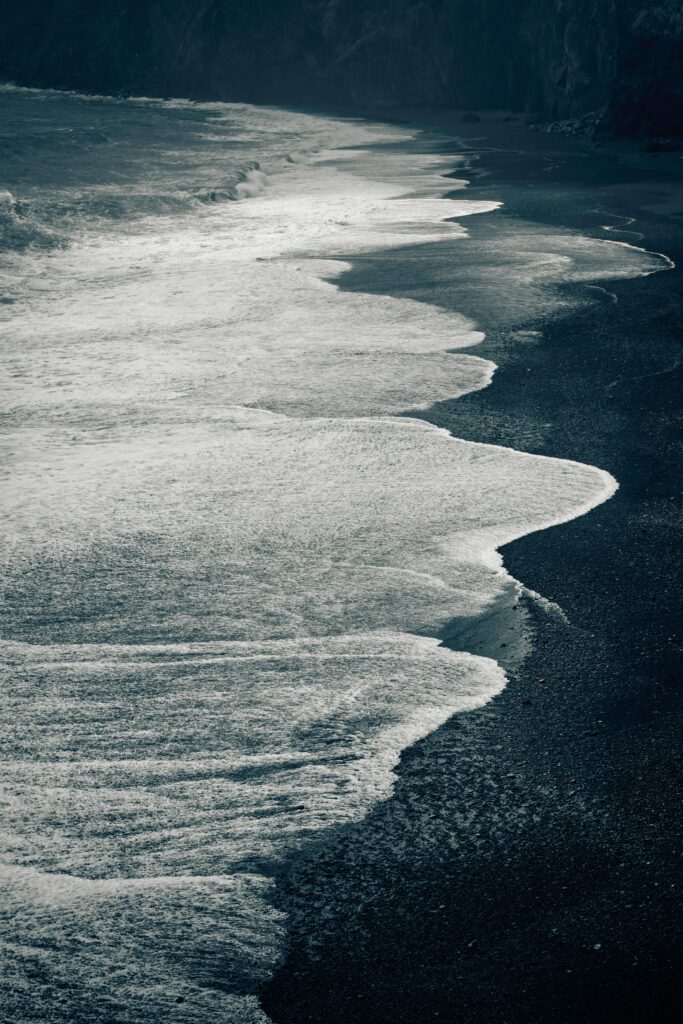
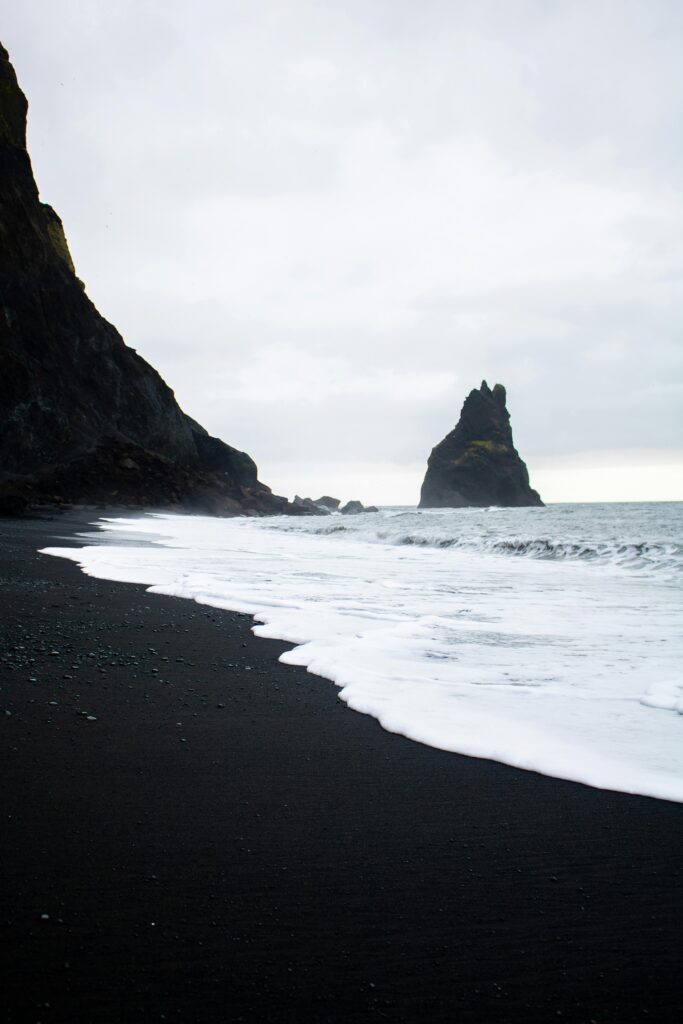
21. Explore Black Sand Beaches of Reynisfjara
Reynisfjara may not be the golden sandy shore we usually picture when we think of beautiful beaches, but it’s often named among the most stunning in the world. Iceland is home to around 130 volcanoes, many still active today, including Katla, which has been dormant for over a century but is expected to erupt again in the future. It was a major eruption from Katla that created Reynisfjara, covering the coastline in black volcanic sand and shaping the dramatic landscape we see today.
Located just off the Ring Road, the beach is dramatic and feels cinematic with its dark, moody shoreline. While there are many volcanic beaches around the world, none are as unique as Reynisfjara. The beach stretches from Dyrhólaey, the southern most point in Iceland, all the way to Vik, a remote seafront village. Reynisfjara is also home to its iconic sea stacks. According to Icelandic folklore, these sea stacks were once trolls, trying to drag a ship to shore. However they didn’t realise the sun was rising and they turned to stone as soon as the sun touched them.
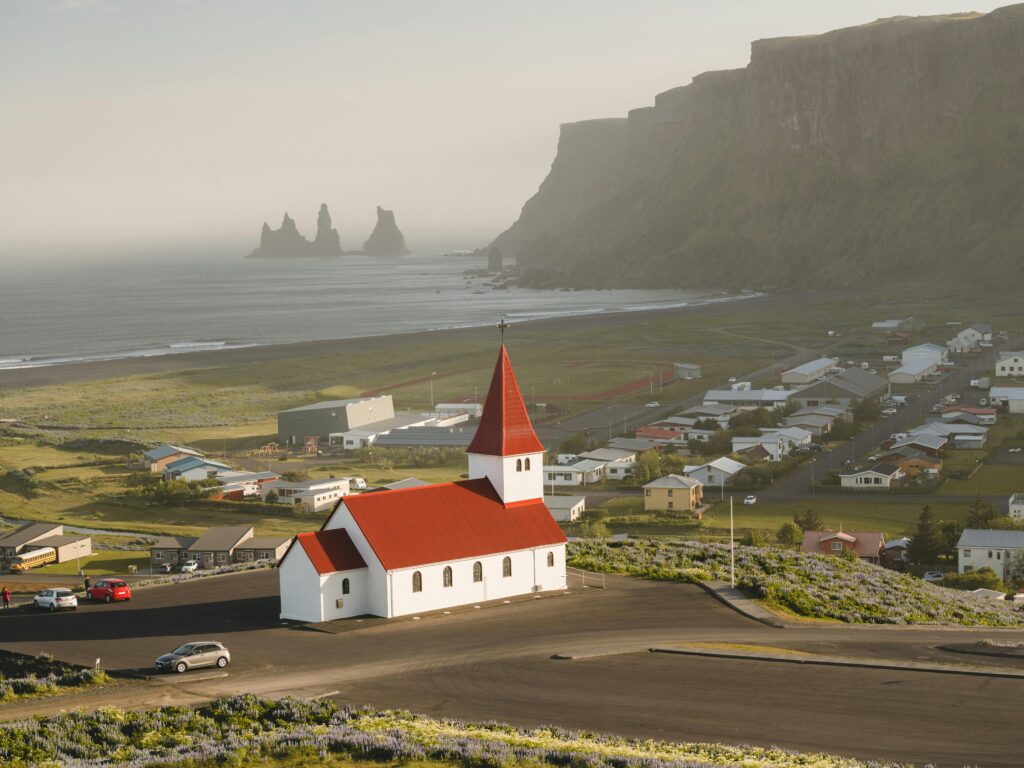
22. Check Out Charming Vik
The small village of Vík is the southernmost settlement in Iceland. Surrounded by dramatic cliffs, black sand beaches, and the iconic Reynisdrangar. Vík is as scenic as it is welcoming.
The town itself is tiny, but its red-roofed church perched on the hillside has become hard to miss. From the hills are stunning sweeping views over the village and coastline. Vík is also a great base for exploring nearby highlights like Reynisfjara beach, Dyrhólaey promontory, and the Mýrdalsjökull glacier that looms in the background. Whether you pause here for a coffee or stay overnight to catch the sunset (or the northern lights in winter), Vík is a charming place to slow down and soak in the beauty of Iceland’s South Coast.
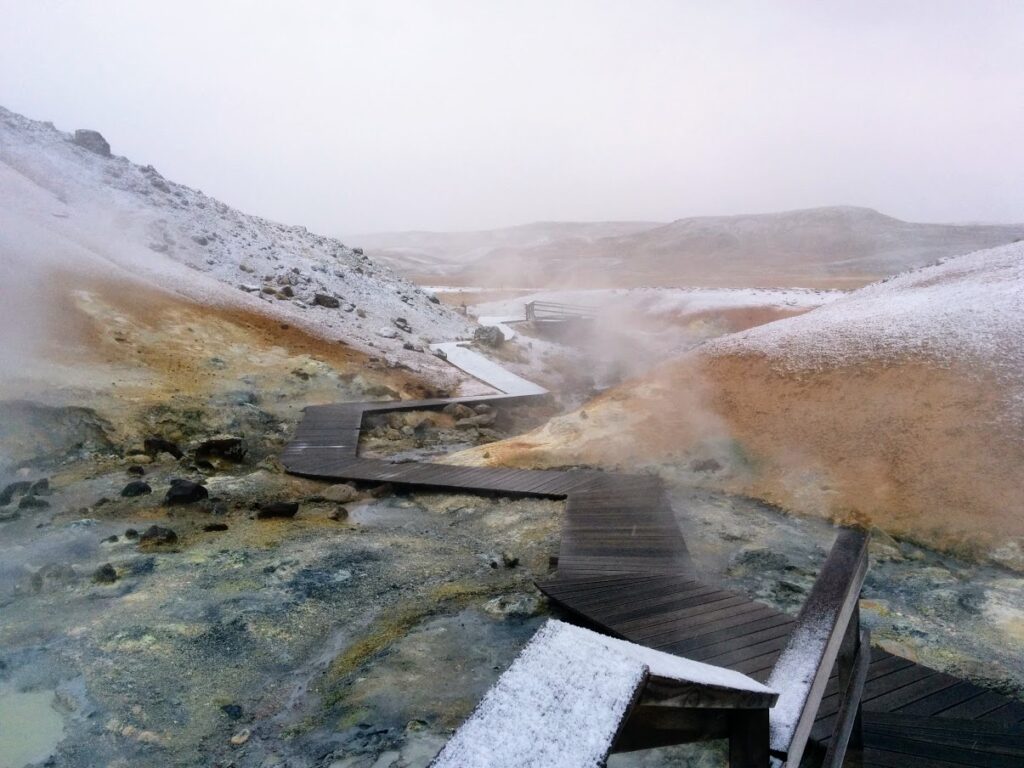
23. Explore the Reykjanes Peninsula and the Geothermal areas
You can’t visit Iceland without visiting some form of its geothermal activity. Two areas we particularly enjoyed visiting were Gunnuhver and Krysuvik, located about 40 minutes apart on the Reykjanes Peninsula.
Gunnuhver is located in a highly volcanic region of Iceland, due to its proximity to the Mid-Atlantic Rift. A bit off the beaten track, Gunnuhver is an active and incredibly impressive geothermal field. While further up the road is Krysuvik. Both are filled with bubbling, steamy (and eggy smelling) mud pools. But don’t let the sulphur smells put you off! Experiencing the earth literally bubbling around you at hundreds of degrees is quite a sight to behold! There are wooden walkways and viewing platforms where you can look out at the bubbling pools around you.
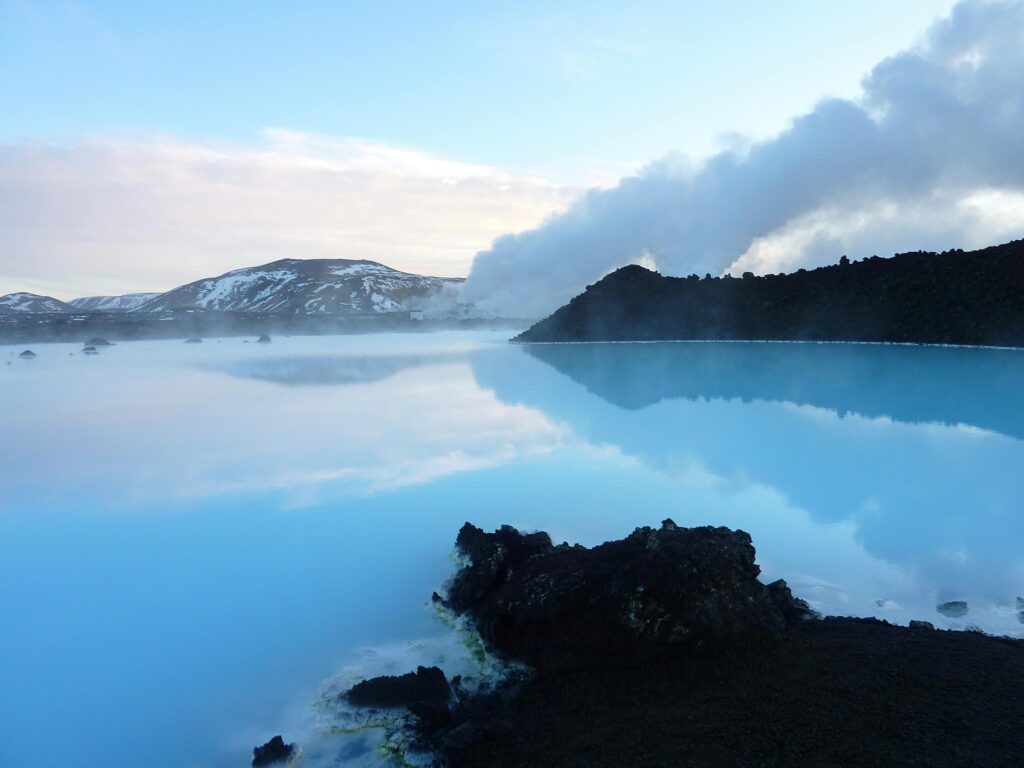
24. Have a soak in Iceland’s geothermal pools
As Iceland’s most famous geothermal spa, understandably it is one of the top things to see and do in Iceland for many first-timers. Located in a lava field on the Reykjanes Peninsula, its milky-blue waters get their colour from the high silica content, which also gives the lagoon its signature skin-softening properties. The pools stay at a soothing 37–40°C year-round, making it the perfect place to relax year-round.
What sets the Blue Lagoon apart from other hot springs is the luxurious experience it offers. You can indulge in silica mud masks, enjoy drinks from the swim-up bar, or even book unique in-water massages! These treatments are performed while you float in the warm lagoon itself, adding an unforgettable touch of relaxation. Modern facilities, on-site restaurants, and a choice of premium packages make the Blue Lagoon more of a destination than a quick stop.
Though it’s the most commercial of Iceland’s geothermal spas, its combination of comfort, natural beauty, and one-of-a-kind treatments makes it worth the visit.
Other Things to See & Do in Iceland
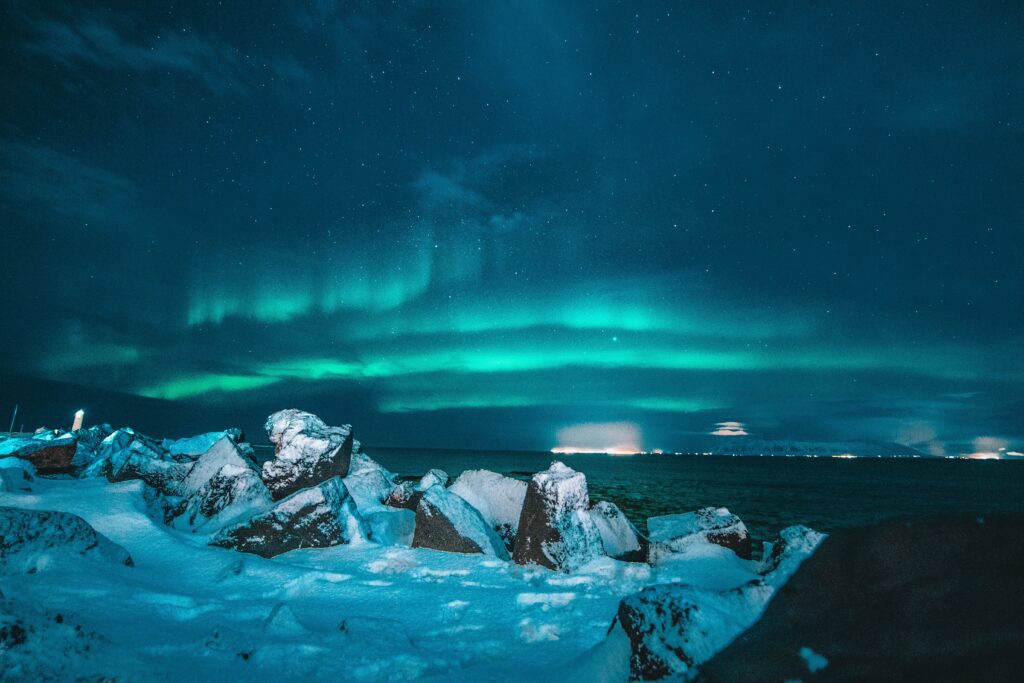
25. Hunt for the Northern Lights
Whatever time of year you visit, Iceland has something for everyone. History, culture, stunning scenery, dramatic landscapes and vibrant wildlife. But one of the TOP things to do in Iceland if you visit during the darker months of October to March, is the chance to witness the Northern Lights.
The opportunity to see these stunning displays is a once-in-a-lifetime opportunity for many. The lights are unpredictable and rely on near-perfect conditions to be seen, and of course nature offers no guarantees. However the pay-off of witnessing the lights with your own eyes makes all the hard work and late nights worthwhile.
There are many companies in Iceland who go hunting for the lights. Some will even re-book you free of charge if you’re unsuccessful on your first attempt. Alternatively you can self-drive and go looking for the lights yourself. We have written a post about our own hunt for the Northern Lights, including driving through an insane blizzard to reach them!
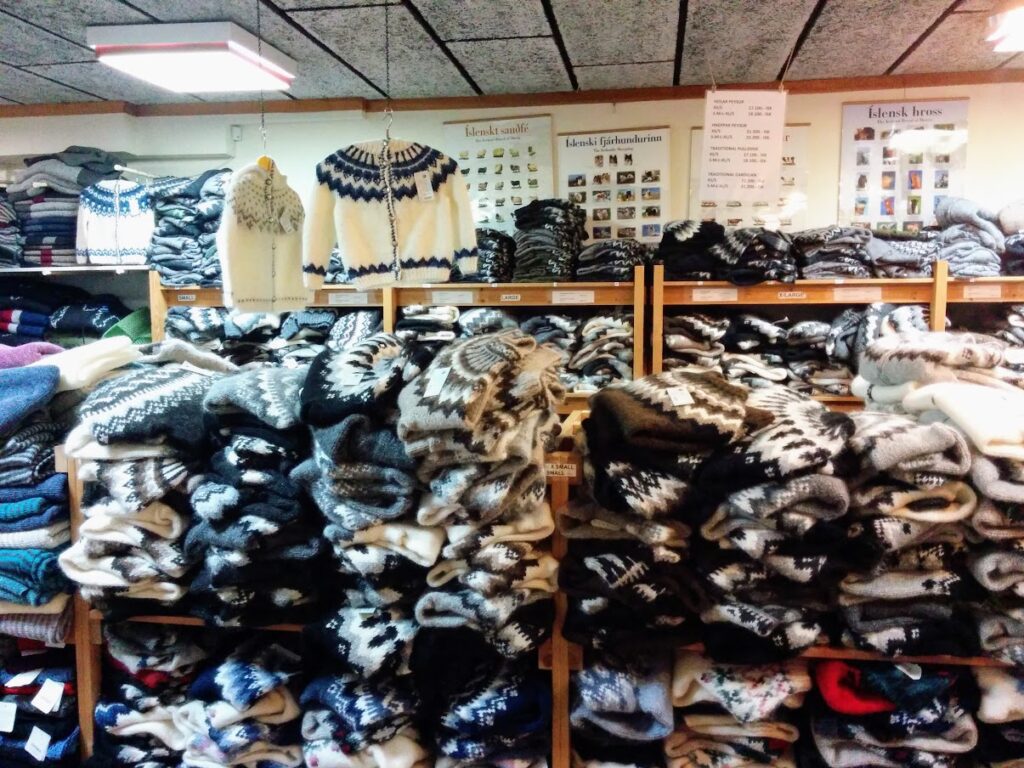
26. Treat Yo’self to Some Genuine Icelandic knitwear
Also unique to Iceland are its iconic Icelandic jumpers – or lopapeysa. These jumpers are made from 100% unspun Icelandic sheep’s wool. They’re incredibly warm, with high insulating properties – perfect if you’re visiting Iceland during the winter time.
You will find plenty of jumpers for sale in stores around Iceland in the style of a classic lopapeysa. However these tend to be made in China and are not from genuine Icelandic sheep’s wool. A genuine lopapeysa is the perfect souvenir from your time in Iceland and the perfect addition to your list of things to do in Iceland.
We purchased ours from the Hand Knitting Association in Reykjavik. This small store is filled to the brim with handknitted jumpers in varying sizes, colours and styles. You will be spoilt for choice! But it’s worth noting although a unique and iconic souvenir, these jumpers are far from cheap. But due to the high-quality material and time taken to hand knit, you will not be disappointed!
If a jumper isn’t tickling your fancy, they also make many other items, from blankets and gloves, to hats. We also purchased a puffin blanket which we love!
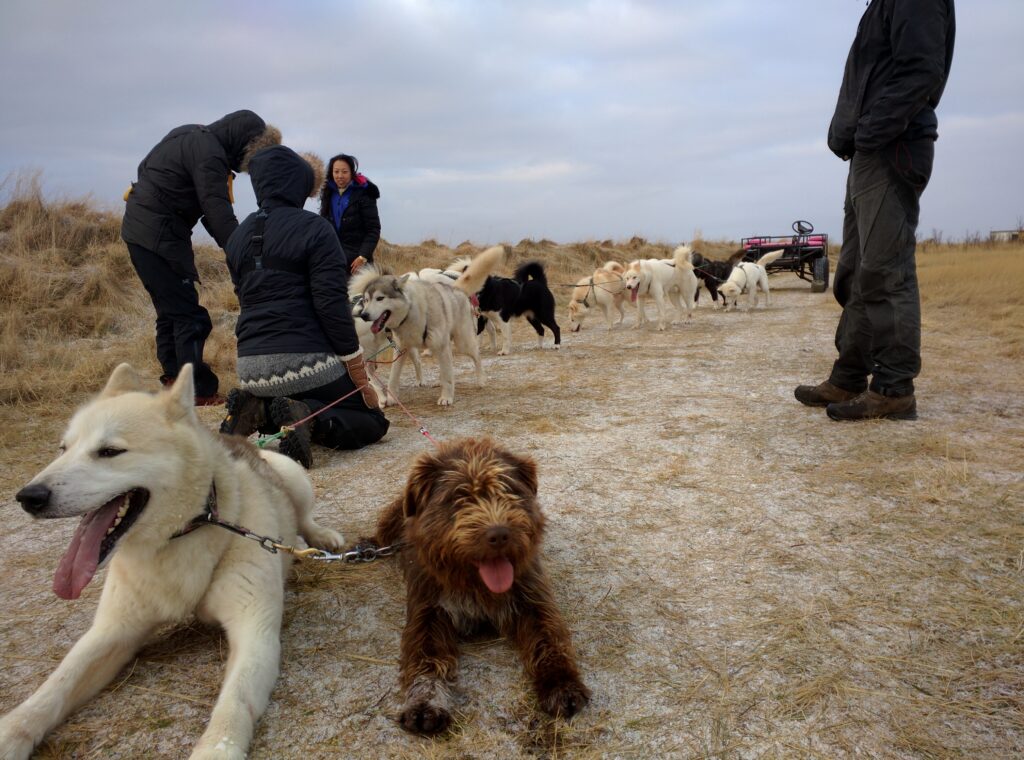
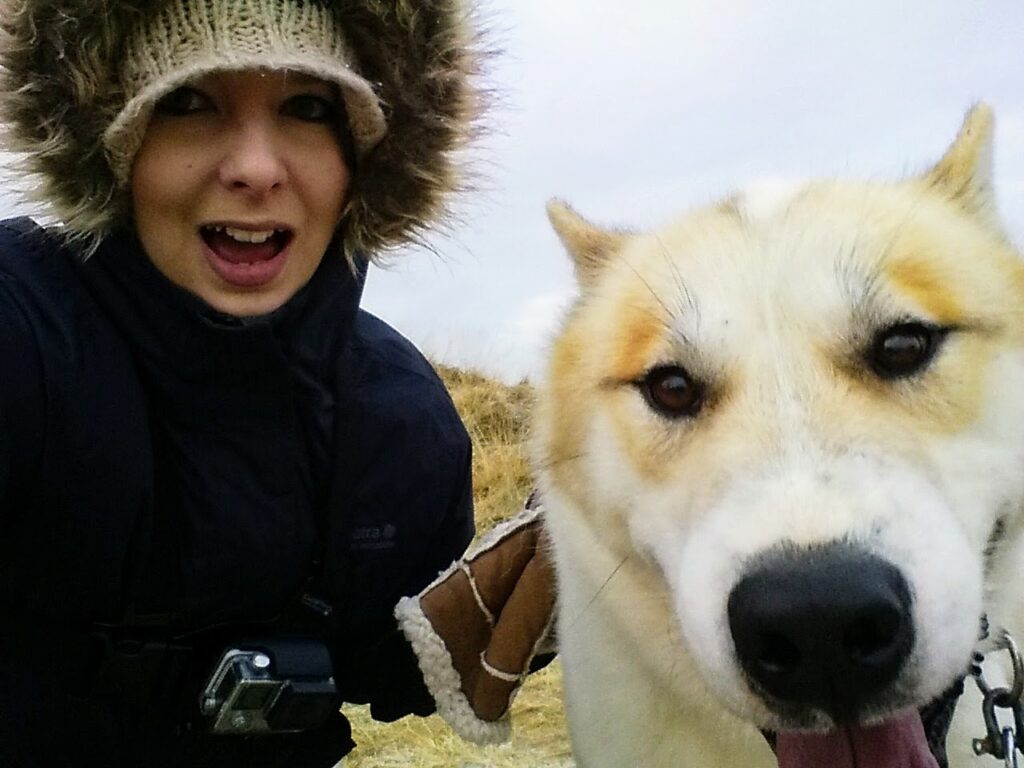
27. Howl With Laughter Dog Sledding
Dog sledding in Iceland is a thrilling experience! While typically you’ll imagine gliding over snow-covered plains behind a team of eager dogs, the experience isn’t limited to snow! At this point in our trip, we weren’t #blessed with snow, but the team used wheeled carts for the dogs to pull. Which was just as effective! The dogs still pull you through the scenery at pace, their excitement and energy making it unforgettable. To be honest, their excitement is a little erratic. But it definitely adds to the hilarity of the experience.
Tours are usually led by experienced mushers who’ll introduce you to the dogs, and explain how they’re trained and cared for. Whether you have the classic snowy feel, or you wheel your way through, dog sledding in Iceland is a truly unique experience.
28. See Iceland’s Adorable Puffins
Puffin watching is one of Iceland’s most memorable wildlife experiences. These colourful seabirds are best seen up close during their summer nesting season from May to August. During this time millions of puffins return to Iceland’s cliffs to breed, making it one of the best places in the world to spot them.
Expect to see them perched on grassy cliff edges, diving into the sea for fish, or waddling around with their bright orange beaks and feet. Some of the most popular spots include Dyrhólaey on the South Coast, the Westman Islands, and the Látrabjarg cliffs in the Westfjords.
Watching puffins in their natural habitat is not only a delight for photographers but also a chance to appreciate Iceland’s rich birdlife. With their quirky movements and friendly appearance, puffins are often nicknamed the “clowns of the sea.” Seeing them in the wild will leave a lasting impression and is one of the most heartwarming things to do in Iceland.
29. Ride the Waves Whale Watching
Whale watching in Iceland is a truly breathtaking experience. Iceland’s nutrient-rich waters attract a wide variety of whales, from minke whales and humpbacks to dolphins. Sometimes the occasional appearance of orcas and even blue whales! Imagine!
Tours run year-round, but the summer months (April–October) offer the best conditions, with calmer seas and higher chances of sightings. Popular departure points include Reykjavík’s Old Harbour, the whale-watching capital of Húsavík in the north, and Akureyri in Eyjafjörður. Whale watching is so worth doing for the chance to see these majestic animals up close. Iceland really does have it all!
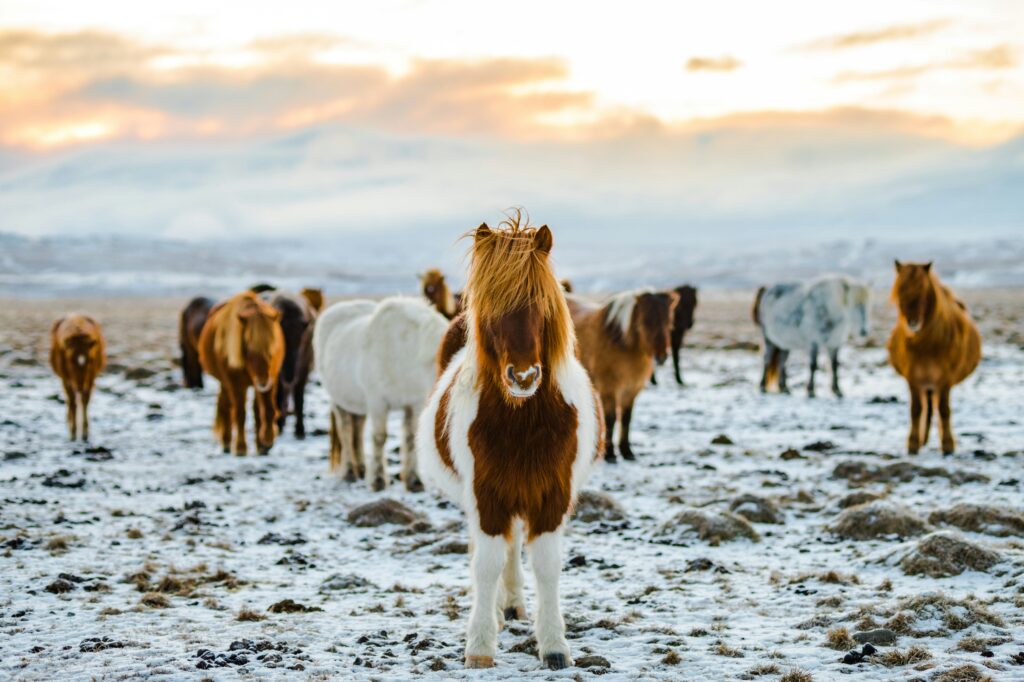
30. Spot an Icelandic Pony
Icelandic pony’s are one of the country’s most beloved symbols. Instantly recognisable for their thick mane, and friendly nature. They were brought to Iceland by the first Viking settlers over a thousand years ago!
You can expect to see them grazing in fields all across the country, often eager to wander over and greet you as you pass by. Horse riding tours are available year-round, from short rides through lava fields and valleys to multi-day treks in the highlands.
They’ve been purebred for centuries, with no other horses allowed to be imported into the country, preserving their unique traits. Meeting them is a highlight of any trip to Iceland, whether you ride them or simply admire them from the sidelines.
Things to do in Iceland FAQs
When is the best time of year to visit Iceland?
It depends on what you want to see. The summer (June–August) offers long daylight hours, mild weather, and access to the highlands. The winter (November–February) is best for the Northern Lights and snowy landscapes, though the days are much shorter. Spring and autumn bring fewer crowds and lower prices, with a good mix of both summer and winter experiences.
Do I need to rent a car to explore Iceland?
Not necessarily. Guided tours cover most of the main things do in Iceland, like the Golden Circle and South Coast. However, renting a car does give you much more freedom to explore at your own pace and visit off-the-beaten-path locations. For winter driving, a 4×4 is strongly recommended!
What should I pack for a trip to Iceland?
Whatever time of year you visit, layers are key. Bring a waterproof jacket and trousers, sturdy hiking boots, warm base layers, gloves, and a hat. Even in summer, the weather can change quickly. Don’t forget a swimsuit and towel for geothermal pools, plus a reusable water bottle — Icelandic tap water is some of the purest in the world.
How long should I spend in Iceland?
A short trip of 3–5 days is enough to see highlights like the Golden Circle and South Coast. But more time is never wasted Iceland. With 7–10 days, you can explore even further or spend more time uncovering Iceland’s hidden gems. Two weeks or more allows you to see the whole island and explore the famous Ring Road.
For some inspiration, check out our 3 – 7 days in Iceland itineraries.
Get in Touch!
We hope you enjoyed our list of the top things to do in Iceland! Hopefully you’ve got some new ideas to tick off. These are just based on our own experiences, but there is still so much more to explore across the south of Iceland and the wider country.
If you’ve visited any of these sights, please share your experiences below, or if there’s something missing that you’d recommend feel free to share below – we’d love to hear them! If you found our blog helpful, check out our Insta @welovetravel.in – if you give us a follow don’t forget to say hey! ✌️
For more Iceland travel inspiration check out our other guides and Trip Reports below:

